The Role of Human Resource Management
VerifiedAdded on 2020/01/21
|18
|6132
|467
AI Summary
This assignment examines the crucial role of human resource management (HRM) in driving organizational success. It explores various HRM practices, their influence on employee attitudes and behaviors, and the overall impact on organizational outcomes. The discussion encompasses topics such as high-performance work systems, talent management, and the challenges faced by HRM in a globalized world.
Contribute Materials
Your contribution can guide someone’s learning journey. Share your
documents today.
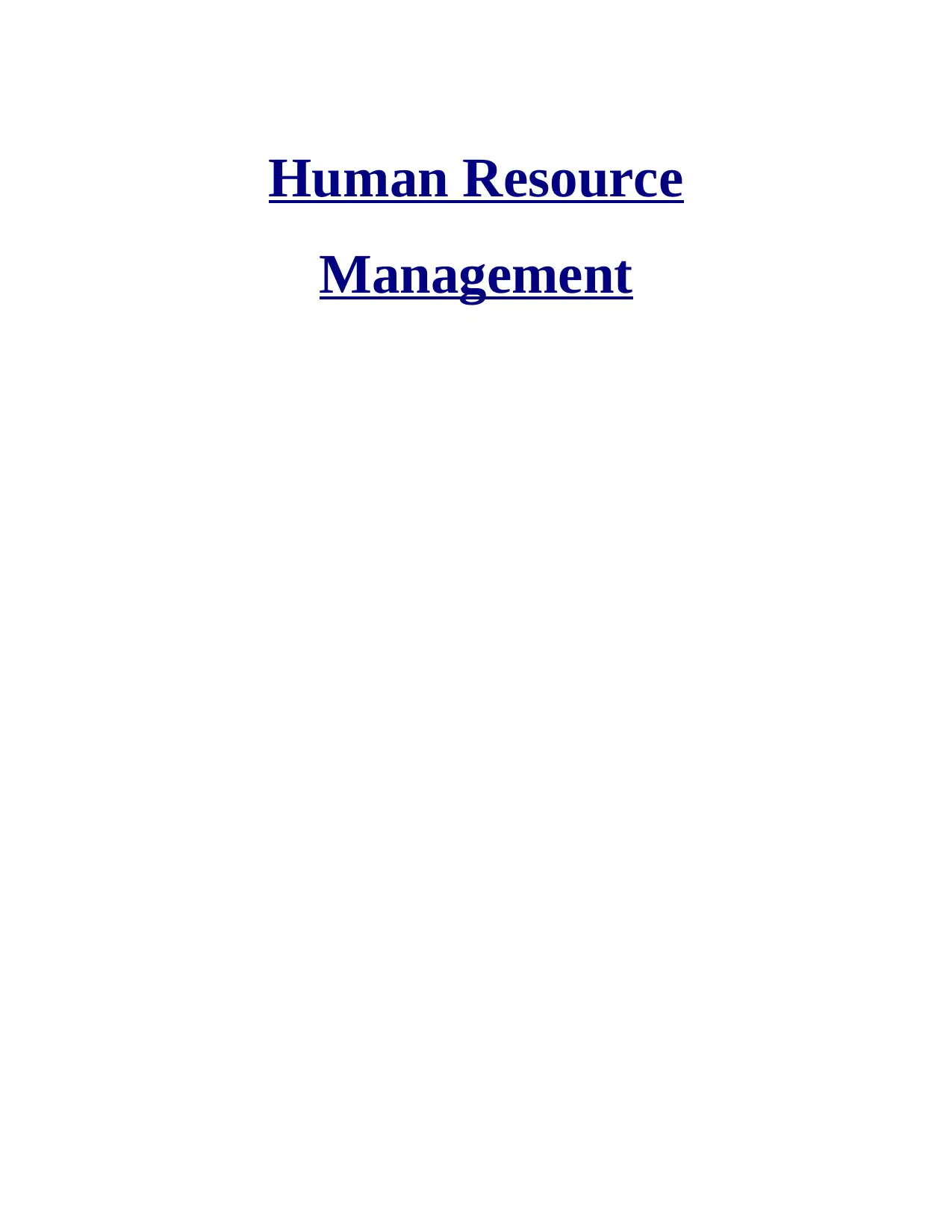
Human Resource
Management
Management
Secure Best Marks with AI Grader
Need help grading? Try our AI Grader for instant feedback on your assignments.
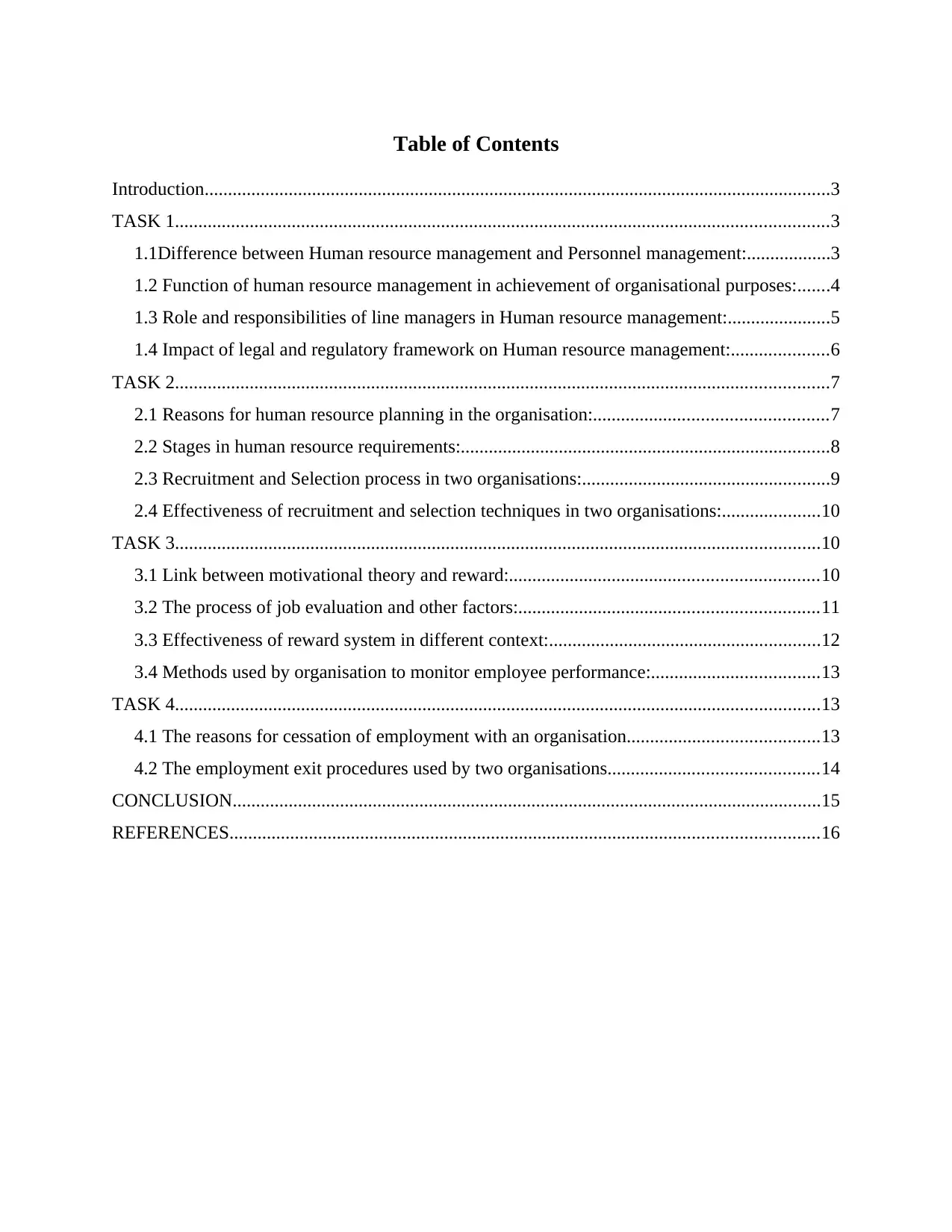
Table of Contents
Introduction......................................................................................................................................3
TASK 1............................................................................................................................................3
1.1Difference between Human resource management and Personnel management:..................3
1.2 Function of human resource management in achievement of organisational purposes:.......4
1.3 Role and responsibilities of line managers in Human resource management:......................5
1.4 Impact of legal and regulatory framework on Human resource management:.....................6
TASK 2............................................................................................................................................7
2.1 Reasons for human resource planning in the organisation:..................................................7
2.2 Stages in human resource requirements:...............................................................................8
2.3 Recruitment and Selection process in two organisations:.....................................................9
2.4 Effectiveness of recruitment and selection techniques in two organisations:.....................10
TASK 3..........................................................................................................................................10
3.1 Link between motivational theory and reward:..................................................................10
3.2 The process of job evaluation and other factors:................................................................11
3.3 Effectiveness of reward system in different context:..........................................................12
3.4 Methods used by organisation to monitor employee performance:....................................13
TASK 4..........................................................................................................................................13
4.1 The reasons for cessation of employment with an organisation.........................................13
4.2 The employment exit procedures used by two organisations.............................................14
CONCLUSION..............................................................................................................................15
REFERENCES..............................................................................................................................16
Introduction......................................................................................................................................3
TASK 1............................................................................................................................................3
1.1Difference between Human resource management and Personnel management:..................3
1.2 Function of human resource management in achievement of organisational purposes:.......4
1.3 Role and responsibilities of line managers in Human resource management:......................5
1.4 Impact of legal and regulatory framework on Human resource management:.....................6
TASK 2............................................................................................................................................7
2.1 Reasons for human resource planning in the organisation:..................................................7
2.2 Stages in human resource requirements:...............................................................................8
2.3 Recruitment and Selection process in two organisations:.....................................................9
2.4 Effectiveness of recruitment and selection techniques in two organisations:.....................10
TASK 3..........................................................................................................................................10
3.1 Link between motivational theory and reward:..................................................................10
3.2 The process of job evaluation and other factors:................................................................11
3.3 Effectiveness of reward system in different context:..........................................................12
3.4 Methods used by organisation to monitor employee performance:....................................13
TASK 4..........................................................................................................................................13
4.1 The reasons for cessation of employment with an organisation.........................................13
4.2 The employment exit procedures used by two organisations.............................................14
CONCLUSION..............................................................................................................................15
REFERENCES..............................................................................................................................16
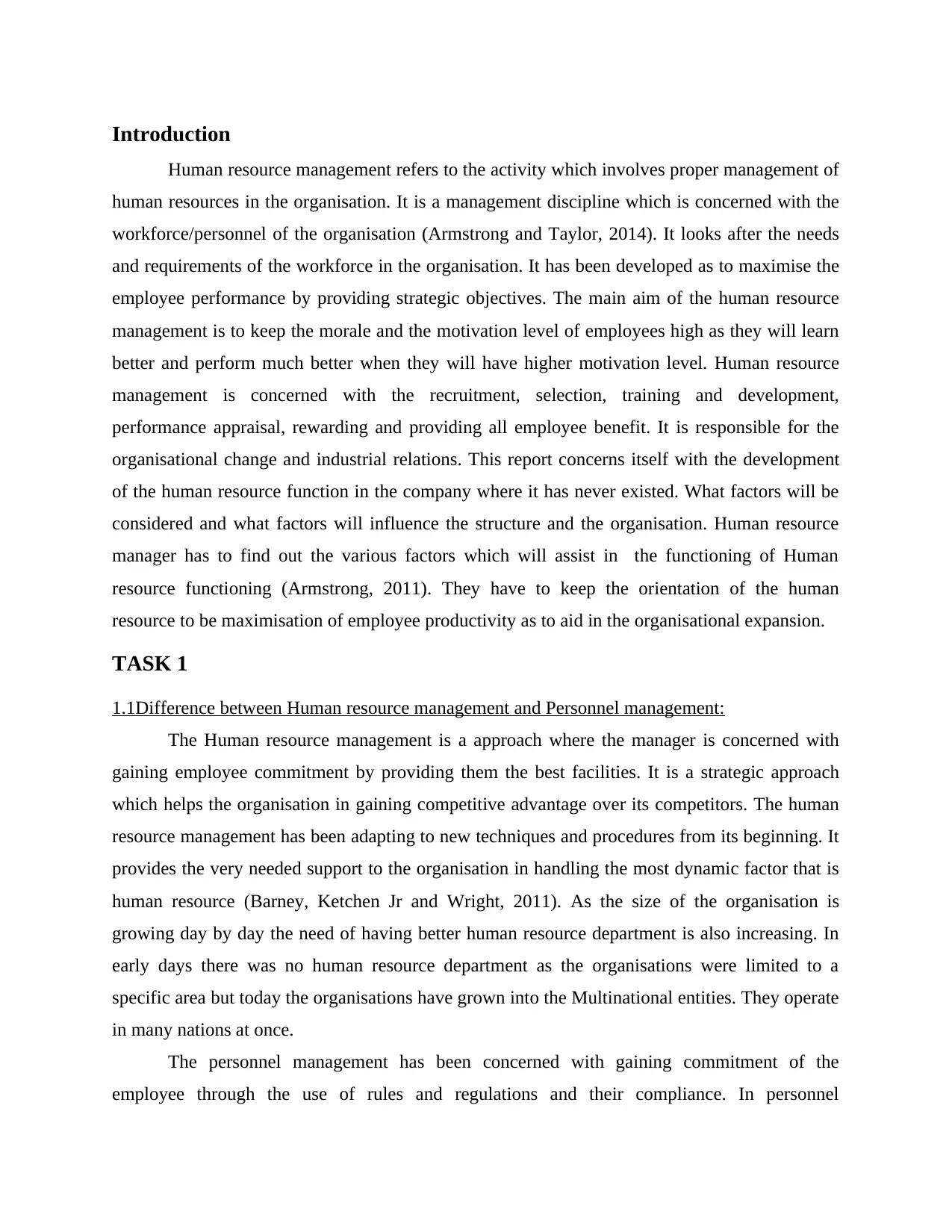
Introduction
Human resource management refers to the activity which involves proper management of
human resources in the organisation. It is a management discipline which is concerned with the
workforce/personnel of the organisation (Armstrong and Taylor, 2014). It looks after the needs
and requirements of the workforce in the organisation. It has been developed as to maximise the
employee performance by providing strategic objectives. The main aim of the human resource
management is to keep the morale and the motivation level of employees high as they will learn
better and perform much better when they will have higher motivation level. Human resource
management is concerned with the recruitment, selection, training and development,
performance appraisal, rewarding and providing all employee benefit. It is responsible for the
organisational change and industrial relations. This report concerns itself with the development
of the human resource function in the company where it has never existed. What factors will be
considered and what factors will influence the structure and the organisation. Human resource
manager has to find out the various factors which will assist in the functioning of Human
resource functioning (Armstrong, 2011). They have to keep the orientation of the human
resource to be maximisation of employee productivity as to aid in the organisational expansion.
TASK 1
1.1Difference between Human resource management and Personnel management:
The Human resource management is a approach where the manager is concerned with
gaining employee commitment by providing them the best facilities. It is a strategic approach
which helps the organisation in gaining competitive advantage over its competitors. The human
resource management has been adapting to new techniques and procedures from its beginning. It
provides the very needed support to the organisation in handling the most dynamic factor that is
human resource (Barney, Ketchen Jr and Wright, 2011). As the size of the organisation is
growing day by day the need of having better human resource department is also increasing. In
early days there was no human resource department as the organisations were limited to a
specific area but today the organisations have grown into the Multinational entities. They operate
in many nations at once.
The personnel management has been concerned with gaining commitment of the
employee through the use of rules and regulations and their compliance. In personnel
Human resource management refers to the activity which involves proper management of
human resources in the organisation. It is a management discipline which is concerned with the
workforce/personnel of the organisation (Armstrong and Taylor, 2014). It looks after the needs
and requirements of the workforce in the organisation. It has been developed as to maximise the
employee performance by providing strategic objectives. The main aim of the human resource
management is to keep the morale and the motivation level of employees high as they will learn
better and perform much better when they will have higher motivation level. Human resource
management is concerned with the recruitment, selection, training and development,
performance appraisal, rewarding and providing all employee benefit. It is responsible for the
organisational change and industrial relations. This report concerns itself with the development
of the human resource function in the company where it has never existed. What factors will be
considered and what factors will influence the structure and the organisation. Human resource
manager has to find out the various factors which will assist in the functioning of Human
resource functioning (Armstrong, 2011). They have to keep the orientation of the human
resource to be maximisation of employee productivity as to aid in the organisational expansion.
TASK 1
1.1Difference between Human resource management and Personnel management:
The Human resource management is a approach where the manager is concerned with
gaining employee commitment by providing them the best facilities. It is a strategic approach
which helps the organisation in gaining competitive advantage over its competitors. The human
resource management has been adapting to new techniques and procedures from its beginning. It
provides the very needed support to the organisation in handling the most dynamic factor that is
human resource (Barney, Ketchen Jr and Wright, 2011). As the size of the organisation is
growing day by day the need of having better human resource department is also increasing. In
early days there was no human resource department as the organisations were limited to a
specific area but today the organisations have grown into the Multinational entities. They operate
in many nations at once.
The personnel management has been concerned with gaining commitment of the
employee through the use of rules and regulations and their compliance. In personnel
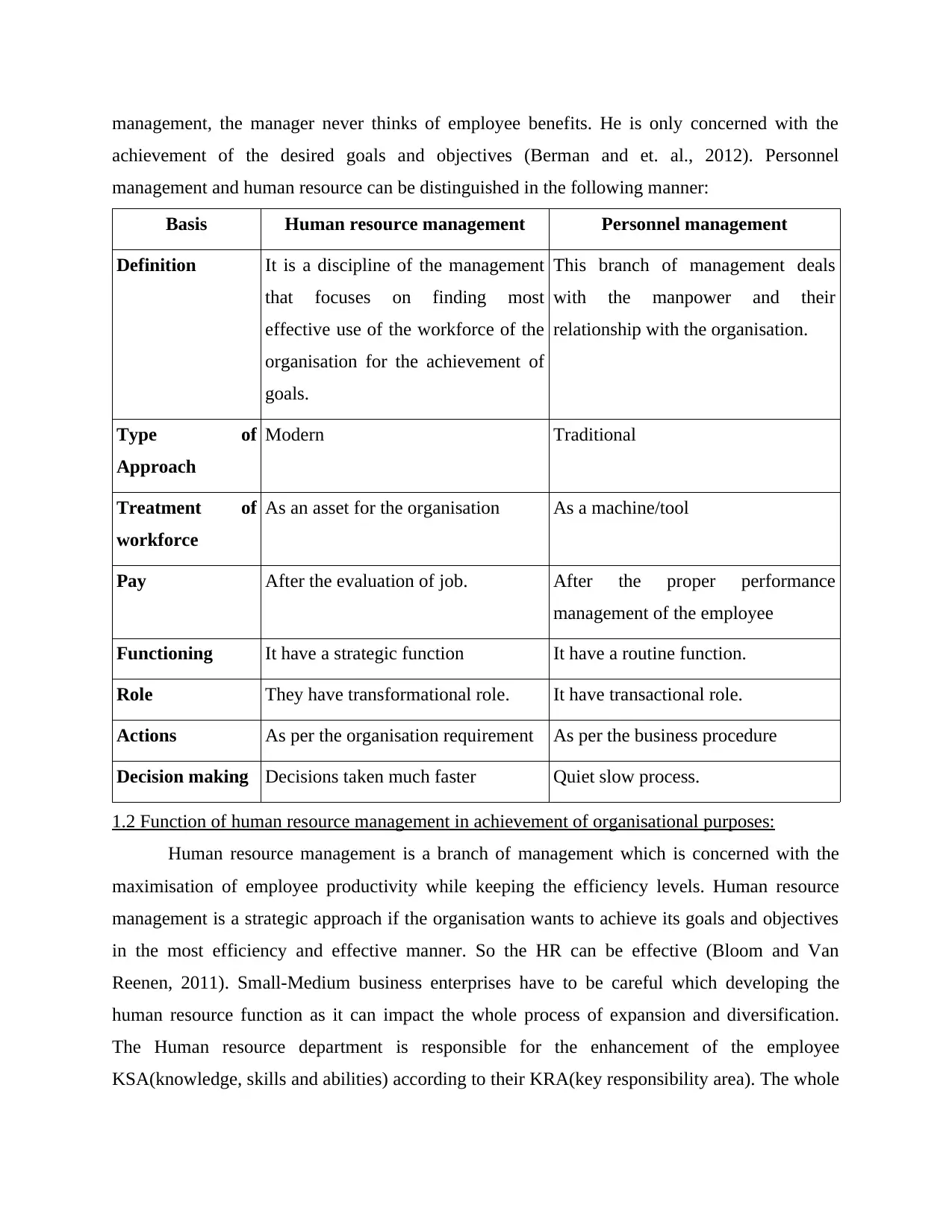
management, the manager never thinks of employee benefits. He is only concerned with the
achievement of the desired goals and objectives (Berman and et. al., 2012). Personnel
management and human resource can be distinguished in the following manner:
Basis Human resource management Personnel management
Definition It is a discipline of the management
that focuses on finding most
effective use of the workforce of the
organisation for the achievement of
goals.
This branch of management deals
with the manpower and their
relationship with the organisation.
Type of
Approach
Modern Traditional
Treatment of
workforce
As an asset for the organisation As a machine/tool
Pay After the evaluation of job. After the proper performance
management of the employee
Functioning It have a strategic function It have a routine function.
Role They have transformational role. It have transactional role.
Actions As per the organisation requirement As per the business procedure
Decision making Decisions taken much faster Quiet slow process.
1.2 Function of human resource management in achievement of organisational purposes:
Human resource management is a branch of management which is concerned with the
maximisation of employee productivity while keeping the efficiency levels. Human resource
management is a strategic approach if the organisation wants to achieve its goals and objectives
in the most efficiency and effective manner. So the HR can be effective (Bloom and Van
Reenen, 2011). Small-Medium business enterprises have to be careful which developing the
human resource function as it can impact the whole process of expansion and diversification.
The Human resource department is responsible for the enhancement of the employee
KSA(knowledge, skills and abilities) according to their KRA(key responsibility area). The whole
achievement of the desired goals and objectives (Berman and et. al., 2012). Personnel
management and human resource can be distinguished in the following manner:
Basis Human resource management Personnel management
Definition It is a discipline of the management
that focuses on finding most
effective use of the workforce of the
organisation for the achievement of
goals.
This branch of management deals
with the manpower and their
relationship with the organisation.
Type of
Approach
Modern Traditional
Treatment of
workforce
As an asset for the organisation As a machine/tool
Pay After the evaluation of job. After the proper performance
management of the employee
Functioning It have a strategic function It have a routine function.
Role They have transformational role. It have transactional role.
Actions As per the organisation requirement As per the business procedure
Decision making Decisions taken much faster Quiet slow process.
1.2 Function of human resource management in achievement of organisational purposes:
Human resource management is a branch of management which is concerned with the
maximisation of employee productivity while keeping the efficiency levels. Human resource
management is a strategic approach if the organisation wants to achieve its goals and objectives
in the most efficiency and effective manner. So the HR can be effective (Bloom and Van
Reenen, 2011). Small-Medium business enterprises have to be careful which developing the
human resource function as it can impact the whole process of expansion and diversification.
The Human resource department is responsible for the enhancement of the employee
KSA(knowledge, skills and abilities) according to their KRA(key responsibility area). The whole
Secure Best Marks with AI Grader
Need help grading? Try our AI Grader for instant feedback on your assignments.
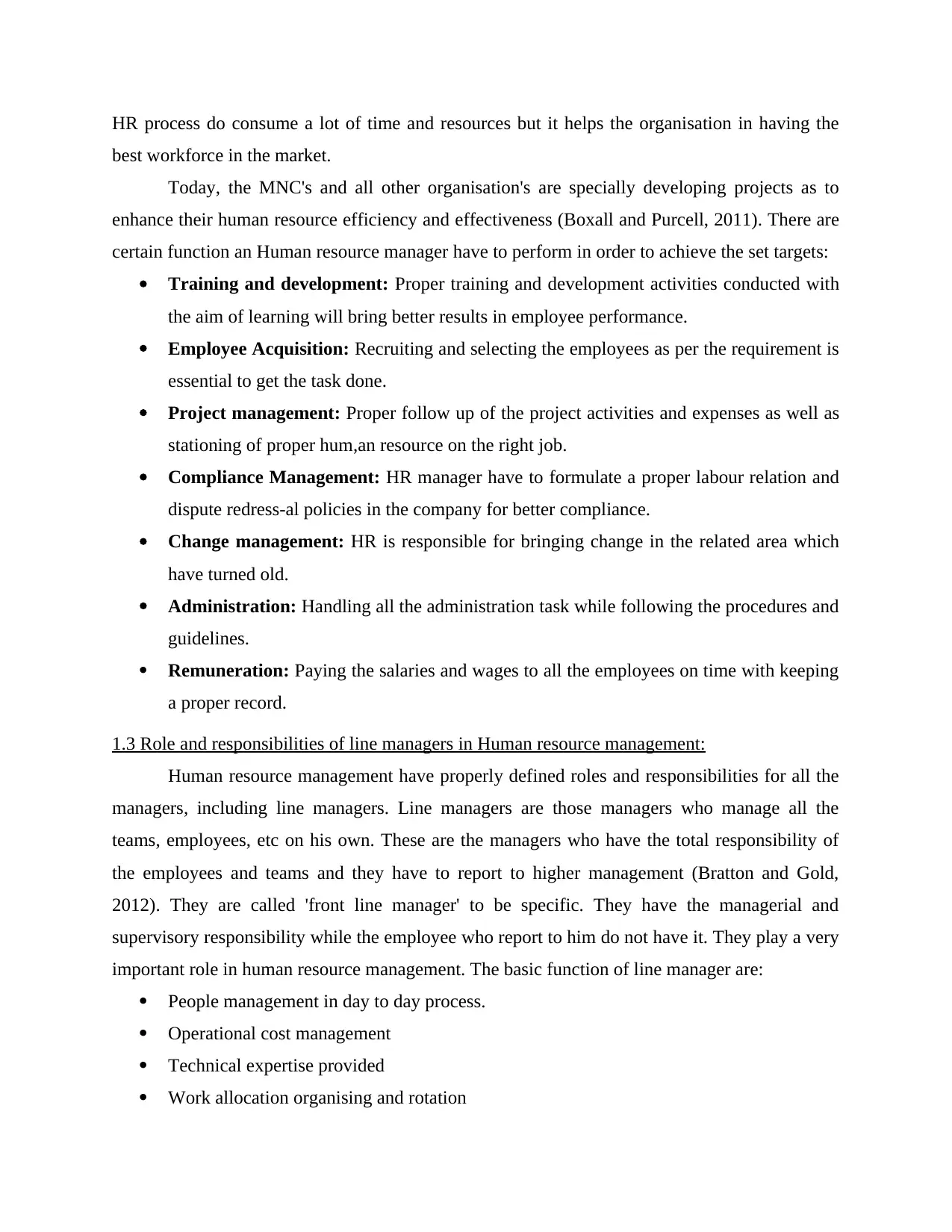
HR process do consume a lot of time and resources but it helps the organisation in having the
best workforce in the market.
Today, the MNC's and all other organisation's are specially developing projects as to
enhance their human resource efficiency and effectiveness (Boxall and Purcell, 2011). There are
certain function an Human resource manager have to perform in order to achieve the set targets:
Training and development: Proper training and development activities conducted with
the aim of learning will bring better results in employee performance.
Employee Acquisition: Recruiting and selecting the employees as per the requirement is
essential to get the task done.
Project management: Proper follow up of the project activities and expenses as well as
stationing of proper hum,an resource on the right job.
Compliance Management: HR manager have to formulate a proper labour relation and
dispute redress-al policies in the company for better compliance.
Change management: HR is responsible for bringing change in the related area which
have turned old.
Administration: Handling all the administration task while following the procedures and
guidelines.
Remuneration: Paying the salaries and wages to all the employees on time with keeping
a proper record.
1.3 Role and responsibilities of line managers in Human resource management:
Human resource management have properly defined roles and responsibilities for all the
managers, including line managers. Line managers are those managers who manage all the
teams, employees, etc on his own. These are the managers who have the total responsibility of
the employees and teams and they have to report to higher management (Bratton and Gold,
2012). They are called 'front line manager' to be specific. They have the managerial and
supervisory responsibility while the employee who report to him do not have it. They play a very
important role in human resource management. The basic function of line manager are:
People management in day to day process.
Operational cost management
Technical expertise provided
Work allocation organising and rotation
best workforce in the market.
Today, the MNC's and all other organisation's are specially developing projects as to
enhance their human resource efficiency and effectiveness (Boxall and Purcell, 2011). There are
certain function an Human resource manager have to perform in order to achieve the set targets:
Training and development: Proper training and development activities conducted with
the aim of learning will bring better results in employee performance.
Employee Acquisition: Recruiting and selecting the employees as per the requirement is
essential to get the task done.
Project management: Proper follow up of the project activities and expenses as well as
stationing of proper hum,an resource on the right job.
Compliance Management: HR manager have to formulate a proper labour relation and
dispute redress-al policies in the company for better compliance.
Change management: HR is responsible for bringing change in the related area which
have turned old.
Administration: Handling all the administration task while following the procedures and
guidelines.
Remuneration: Paying the salaries and wages to all the employees on time with keeping
a proper record.
1.3 Role and responsibilities of line managers in Human resource management:
Human resource management have properly defined roles and responsibilities for all the
managers, including line managers. Line managers are those managers who manage all the
teams, employees, etc on his own. These are the managers who have the total responsibility of
the employees and teams and they have to report to higher management (Bratton and Gold,
2012). They are called 'front line manager' to be specific. They have the managerial and
supervisory responsibility while the employee who report to him do not have it. They play a very
important role in human resource management. The basic function of line manager are:
People management in day to day process.
Operational cost management
Technical expertise provided
Work allocation organising and rotation
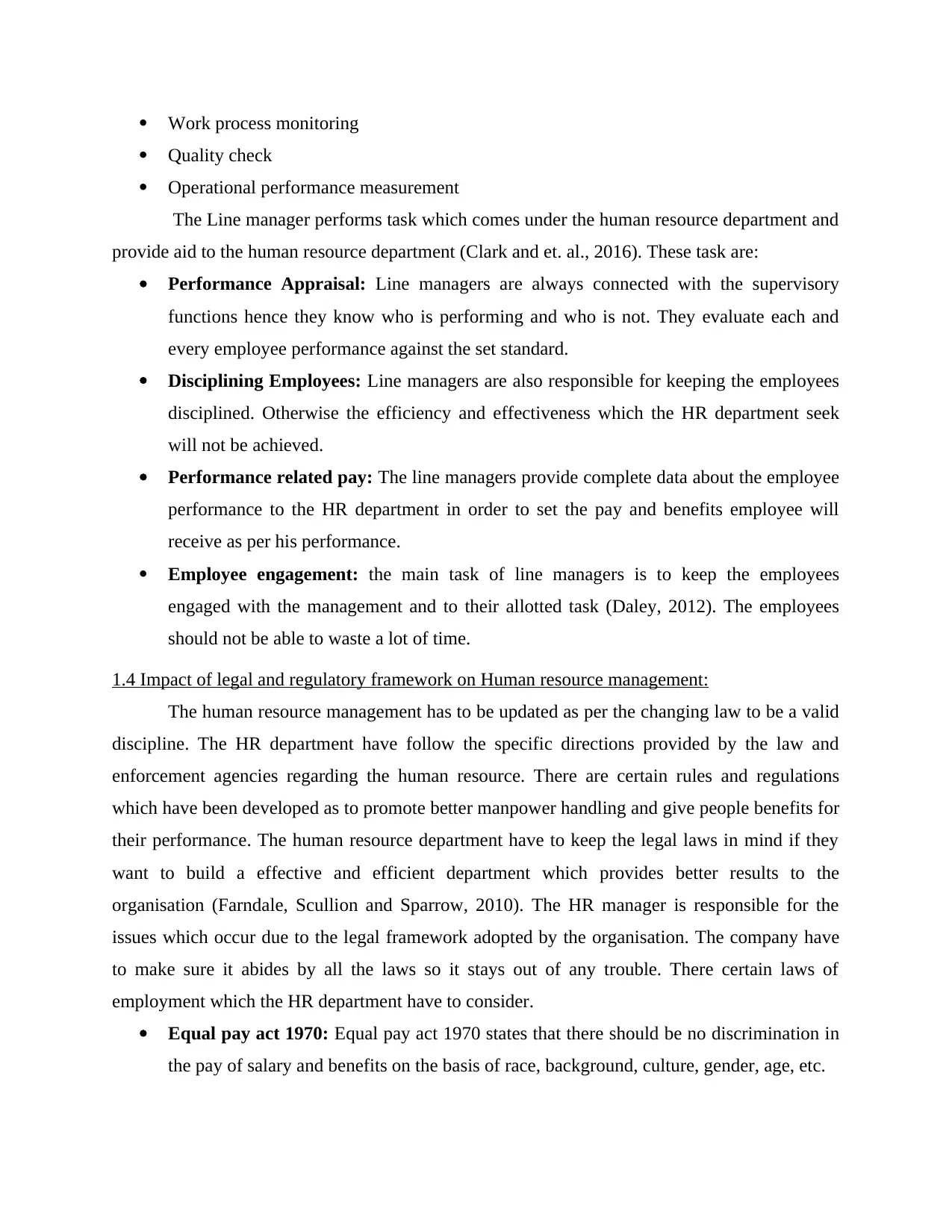
Work process monitoring
Quality check
Operational performance measurement
The Line manager performs task which comes under the human resource department and
provide aid to the human resource department (Clark and et. al., 2016). These task are:
Performance Appraisal: Line managers are always connected with the supervisory
functions hence they know who is performing and who is not. They evaluate each and
every employee performance against the set standard.
Disciplining Employees: Line managers are also responsible for keeping the employees
disciplined. Otherwise the efficiency and effectiveness which the HR department seek
will not be achieved.
Performance related pay: The line managers provide complete data about the employee
performance to the HR department in order to set the pay and benefits employee will
receive as per his performance.
Employee engagement: the main task of line managers is to keep the employees
engaged with the management and to their allotted task (Daley, 2012). The employees
should not be able to waste a lot of time.
1.4 Impact of legal and regulatory framework on Human resource management:
The human resource management has to be updated as per the changing law to be a valid
discipline. The HR department have follow the specific directions provided by the law and
enforcement agencies regarding the human resource. There are certain rules and regulations
which have been developed as to promote better manpower handling and give people benefits for
their performance. The human resource department have to keep the legal laws in mind if they
want to build a effective and efficient department which provides better results to the
organisation (Farndale, Scullion and Sparrow, 2010). The HR manager is responsible for the
issues which occur due to the legal framework adopted by the organisation. The company have
to make sure it abides by all the laws so it stays out of any trouble. There certain laws of
employment which the HR department have to consider.
Equal pay act 1970: Equal pay act 1970 states that there should be no discrimination in
the pay of salary and benefits on the basis of race, background, culture, gender, age, etc.
Quality check
Operational performance measurement
The Line manager performs task which comes under the human resource department and
provide aid to the human resource department (Clark and et. al., 2016). These task are:
Performance Appraisal: Line managers are always connected with the supervisory
functions hence they know who is performing and who is not. They evaluate each and
every employee performance against the set standard.
Disciplining Employees: Line managers are also responsible for keeping the employees
disciplined. Otherwise the efficiency and effectiveness which the HR department seek
will not be achieved.
Performance related pay: The line managers provide complete data about the employee
performance to the HR department in order to set the pay and benefits employee will
receive as per his performance.
Employee engagement: the main task of line managers is to keep the employees
engaged with the management and to their allotted task (Daley, 2012). The employees
should not be able to waste a lot of time.
1.4 Impact of legal and regulatory framework on Human resource management:
The human resource management has to be updated as per the changing law to be a valid
discipline. The HR department have follow the specific directions provided by the law and
enforcement agencies regarding the human resource. There are certain rules and regulations
which have been developed as to promote better manpower handling and give people benefits for
their performance. The human resource department have to keep the legal laws in mind if they
want to build a effective and efficient department which provides better results to the
organisation (Farndale, Scullion and Sparrow, 2010). The HR manager is responsible for the
issues which occur due to the legal framework adopted by the organisation. The company have
to make sure it abides by all the laws so it stays out of any trouble. There certain laws of
employment which the HR department have to consider.
Equal pay act 1970: Equal pay act 1970 states that there should be no discrimination in
the pay of salary and benefits on the basis of race, background, culture, gender, age, etc.
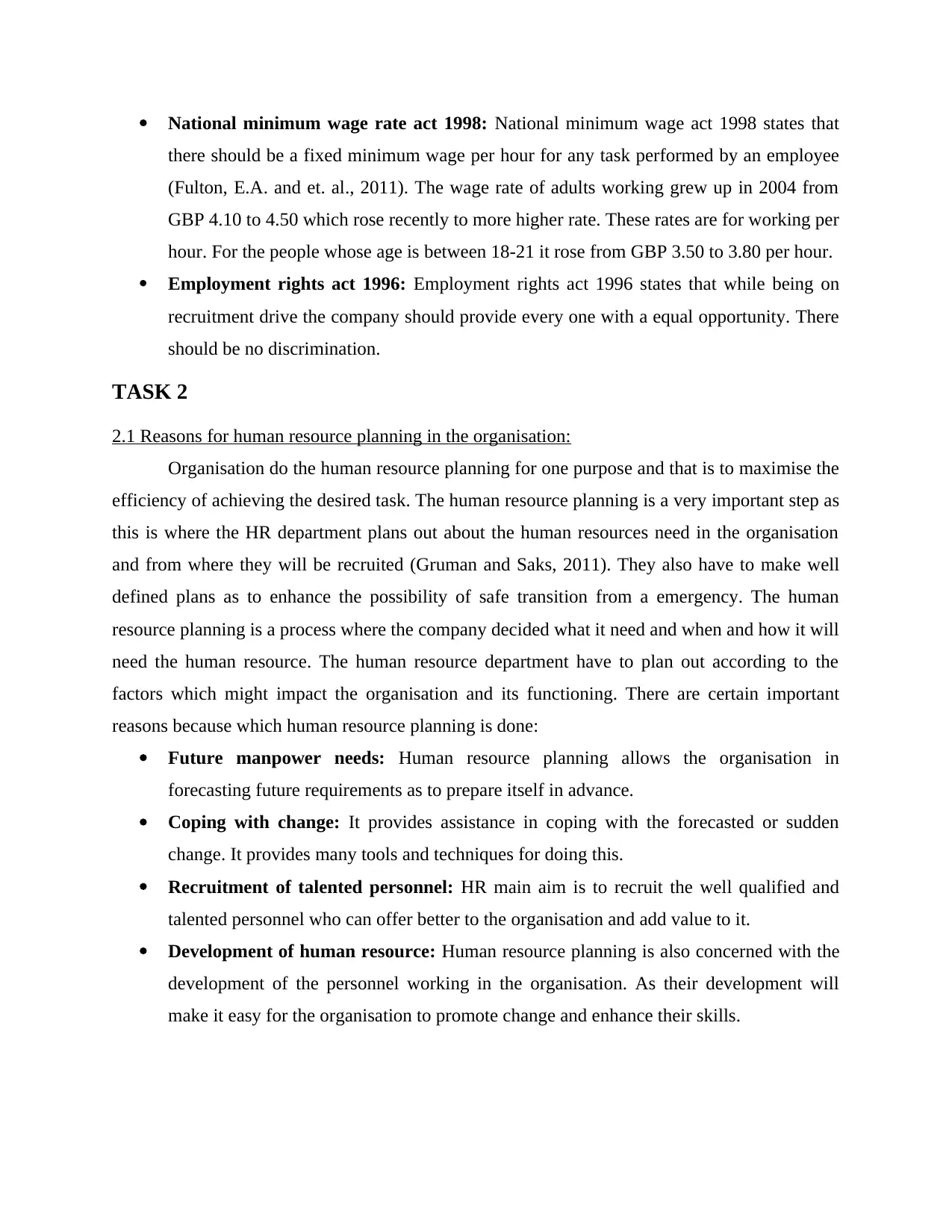
National minimum wage rate act 1998: National minimum wage act 1998 states that
there should be a fixed minimum wage per hour for any task performed by an employee
(Fulton, E.A. and et. al., 2011). The wage rate of adults working grew up in 2004 from
GBP 4.10 to 4.50 which rose recently to more higher rate. These rates are for working per
hour. For the people whose age is between 18-21 it rose from GBP 3.50 to 3.80 per hour.
Employment rights act 1996: Employment rights act 1996 states that while being on
recruitment drive the company should provide every one with a equal opportunity. There
should be no discrimination.
TASK 2
2.1 Reasons for human resource planning in the organisation:
Organisation do the human resource planning for one purpose and that is to maximise the
efficiency of achieving the desired task. The human resource planning is a very important step as
this is where the HR department plans out about the human resources need in the organisation
and from where they will be recruited (Gruman and Saks, 2011). They also have to make well
defined plans as to enhance the possibility of safe transition from a emergency. The human
resource planning is a process where the company decided what it need and when and how it will
need the human resource. The human resource department have to plan out according to the
factors which might impact the organisation and its functioning. There are certain important
reasons because which human resource planning is done:
Future manpower needs: Human resource planning allows the organisation in
forecasting future requirements as to prepare itself in advance.
Coping with change: It provides assistance in coping with the forecasted or sudden
change. It provides many tools and techniques for doing this.
Recruitment of talented personnel: HR main aim is to recruit the well qualified and
talented personnel who can offer better to the organisation and add value to it.
Development of human resource: Human resource planning is also concerned with the
development of the personnel working in the organisation. As their development will
make it easy for the organisation to promote change and enhance their skills.
there should be a fixed minimum wage per hour for any task performed by an employee
(Fulton, E.A. and et. al., 2011). The wage rate of adults working grew up in 2004 from
GBP 4.10 to 4.50 which rose recently to more higher rate. These rates are for working per
hour. For the people whose age is between 18-21 it rose from GBP 3.50 to 3.80 per hour.
Employment rights act 1996: Employment rights act 1996 states that while being on
recruitment drive the company should provide every one with a equal opportunity. There
should be no discrimination.
TASK 2
2.1 Reasons for human resource planning in the organisation:
Organisation do the human resource planning for one purpose and that is to maximise the
efficiency of achieving the desired task. The human resource planning is a very important step as
this is where the HR department plans out about the human resources need in the organisation
and from where they will be recruited (Gruman and Saks, 2011). They also have to make well
defined plans as to enhance the possibility of safe transition from a emergency. The human
resource planning is a process where the company decided what it need and when and how it will
need the human resource. The human resource department have to plan out according to the
factors which might impact the organisation and its functioning. There are certain important
reasons because which human resource planning is done:
Future manpower needs: Human resource planning allows the organisation in
forecasting future requirements as to prepare itself in advance.
Coping with change: It provides assistance in coping with the forecasted or sudden
change. It provides many tools and techniques for doing this.
Recruitment of talented personnel: HR main aim is to recruit the well qualified and
talented personnel who can offer better to the organisation and add value to it.
Development of human resource: Human resource planning is also concerned with the
development of the personnel working in the organisation. As their development will
make it easy for the organisation to promote change and enhance their skills.
Paraphrase This Document
Need a fresh take? Get an instant paraphrase of this document with our AI Paraphraser
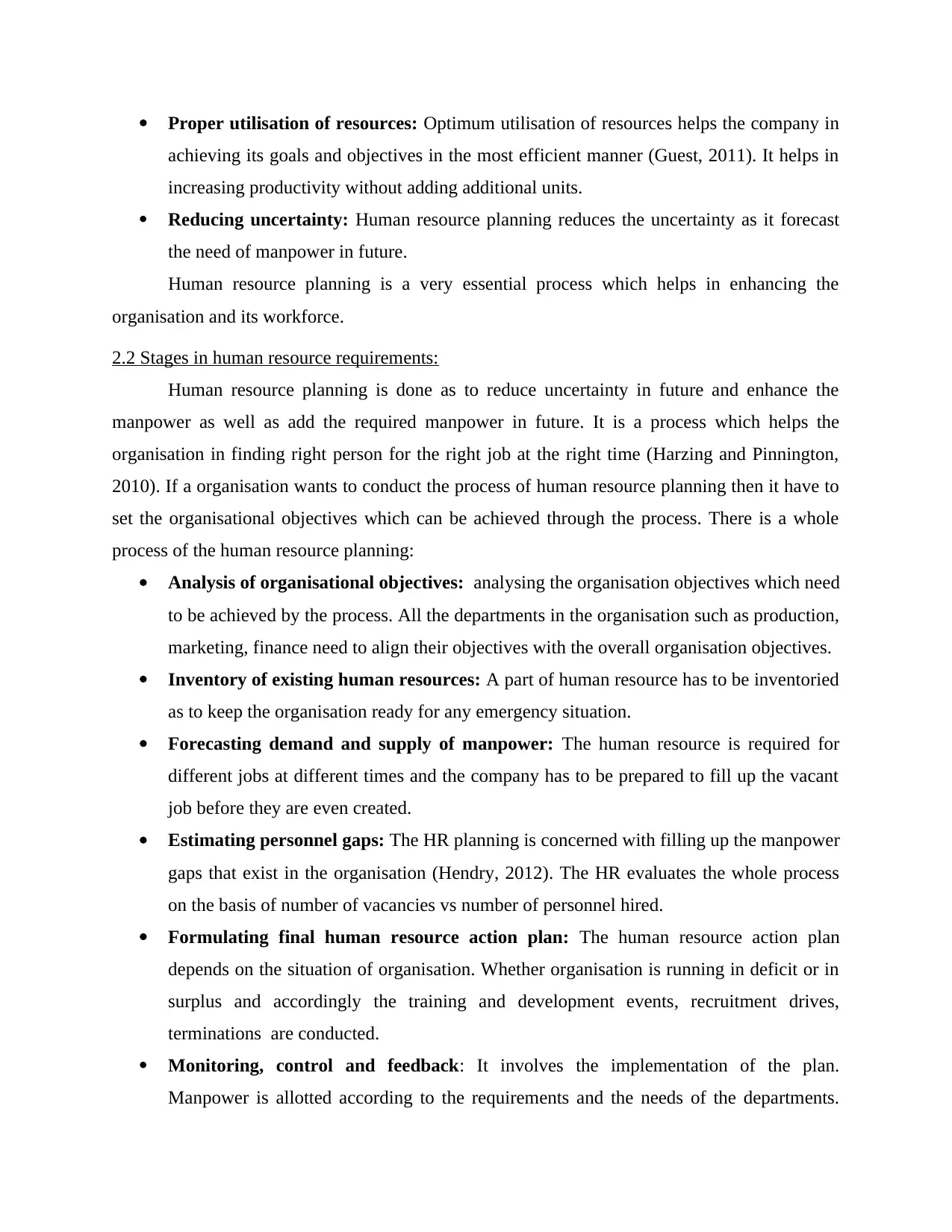
Proper utilisation of resources: Optimum utilisation of resources helps the company in
achieving its goals and objectives in the most efficient manner (Guest, 2011). It helps in
increasing productivity without adding additional units.
Reducing uncertainty: Human resource planning reduces the uncertainty as it forecast
the need of manpower in future.
Human resource planning is a very essential process which helps in enhancing the
organisation and its workforce.
2.2 Stages in human resource requirements:
Human resource planning is done as to reduce uncertainty in future and enhance the
manpower as well as add the required manpower in future. It is a process which helps the
organisation in finding right person for the right job at the right time (Harzing and Pinnington,
2010). If a organisation wants to conduct the process of human resource planning then it have to
set the organisational objectives which can be achieved through the process. There is a whole
process of the human resource planning:
Analysis of organisational objectives: analysing the organisation objectives which need
to be achieved by the process. All the departments in the organisation such as production,
marketing, finance need to align their objectives with the overall organisation objectives.
Inventory of existing human resources: A part of human resource has to be inventoried
as to keep the organisation ready for any emergency situation.
Forecasting demand and supply of manpower: The human resource is required for
different jobs at different times and the company has to be prepared to fill up the vacant
job before they are even created.
Estimating personnel gaps: The HR planning is concerned with filling up the manpower
gaps that exist in the organisation (Hendry, 2012). The HR evaluates the whole process
on the basis of number of vacancies vs number of personnel hired.
Formulating final human resource action plan: The human resource action plan
depends on the situation of organisation. Whether organisation is running in deficit or in
surplus and accordingly the training and development events, recruitment drives,
terminations are conducted.
Monitoring, control and feedback: It involves the implementation of the plan.
Manpower is allotted according to the requirements and the needs of the departments.
achieving its goals and objectives in the most efficient manner (Guest, 2011). It helps in
increasing productivity without adding additional units.
Reducing uncertainty: Human resource planning reduces the uncertainty as it forecast
the need of manpower in future.
Human resource planning is a very essential process which helps in enhancing the
organisation and its workforce.
2.2 Stages in human resource requirements:
Human resource planning is done as to reduce uncertainty in future and enhance the
manpower as well as add the required manpower in future. It is a process which helps the
organisation in finding right person for the right job at the right time (Harzing and Pinnington,
2010). If a organisation wants to conduct the process of human resource planning then it have to
set the organisational objectives which can be achieved through the process. There is a whole
process of the human resource planning:
Analysis of organisational objectives: analysing the organisation objectives which need
to be achieved by the process. All the departments in the organisation such as production,
marketing, finance need to align their objectives with the overall organisation objectives.
Inventory of existing human resources: A part of human resource has to be inventoried
as to keep the organisation ready for any emergency situation.
Forecasting demand and supply of manpower: The human resource is required for
different jobs at different times and the company has to be prepared to fill up the vacant
job before they are even created.
Estimating personnel gaps: The HR planning is concerned with filling up the manpower
gaps that exist in the organisation (Hendry, 2012). The HR evaluates the whole process
on the basis of number of vacancies vs number of personnel hired.
Formulating final human resource action plan: The human resource action plan
depends on the situation of organisation. Whether organisation is running in deficit or in
surplus and accordingly the training and development events, recruitment drives,
terminations are conducted.
Monitoring, control and feedback: It involves the implementation of the plan.
Manpower is allotted according to the requirements and the needs of the departments.
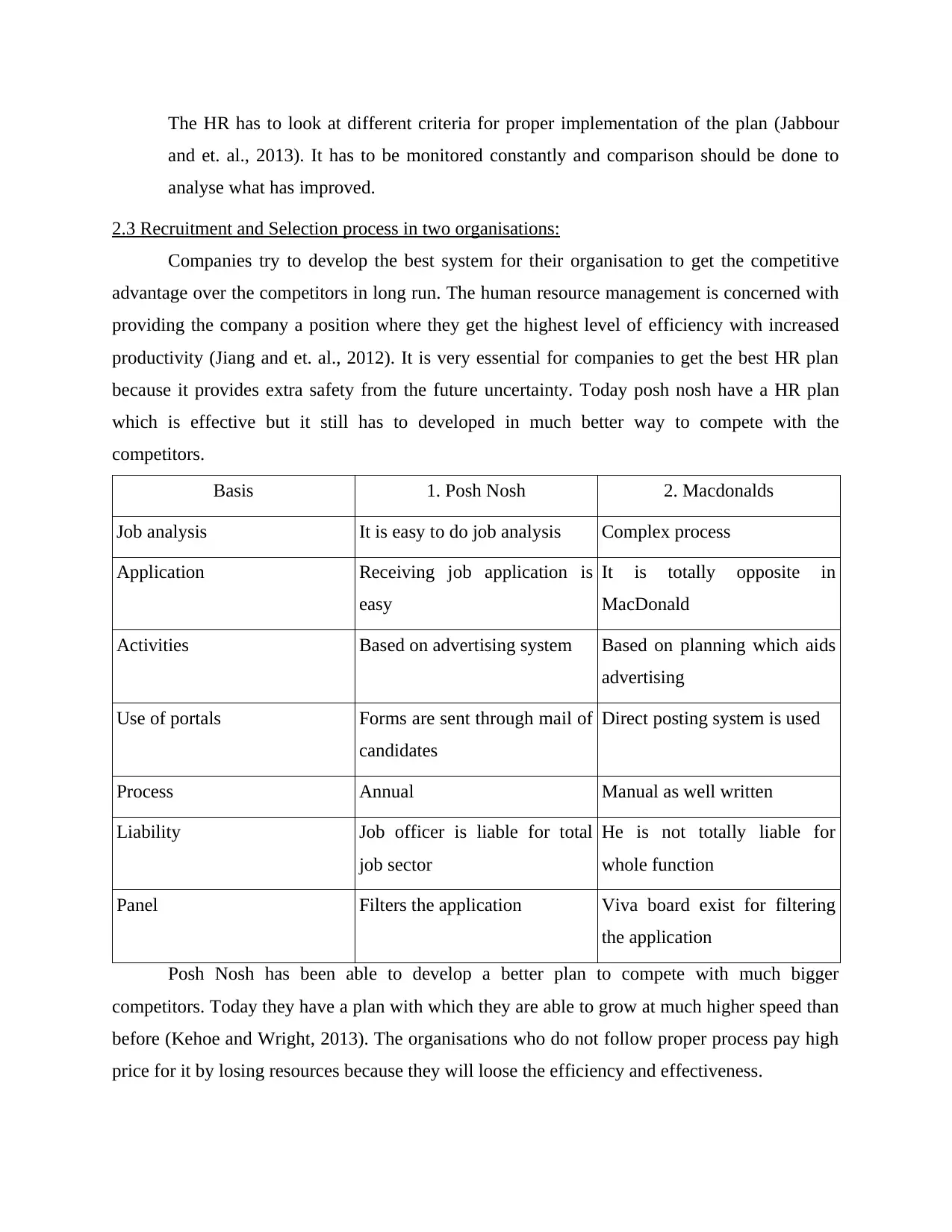
The HR has to look at different criteria for proper implementation of the plan (Jabbour
and et. al., 2013). It has to be monitored constantly and comparison should be done to
analyse what has improved.
2.3 Recruitment and Selection process in two organisations:
Companies try to develop the best system for their organisation to get the competitive
advantage over the competitors in long run. The human resource management is concerned with
providing the company a position where they get the highest level of efficiency with increased
productivity (Jiang and et. al., 2012). It is very essential for companies to get the best HR plan
because it provides extra safety from the future uncertainty. Today posh nosh have a HR plan
which is effective but it still has to developed in much better way to compete with the
competitors.
Basis 1. Posh Nosh 2. Macdonalds
Job analysis It is easy to do job analysis Complex process
Application Receiving job application is
easy
It is totally opposite in
MacDonald
Activities Based on advertising system Based on planning which aids
advertising
Use of portals Forms are sent through mail of
candidates
Direct posting system is used
Process Annual Manual as well written
Liability Job officer is liable for total
job sector
He is not totally liable for
whole function
Panel Filters the application Viva board exist for filtering
the application
Posh Nosh has been able to develop a better plan to compete with much bigger
competitors. Today they have a plan with which they are able to grow at much higher speed than
before (Kehoe and Wright, 2013). The organisations who do not follow proper process pay high
price for it by losing resources because they will loose the efficiency and effectiveness.
and et. al., 2013). It has to be monitored constantly and comparison should be done to
analyse what has improved.
2.3 Recruitment and Selection process in two organisations:
Companies try to develop the best system for their organisation to get the competitive
advantage over the competitors in long run. The human resource management is concerned with
providing the company a position where they get the highest level of efficiency with increased
productivity (Jiang and et. al., 2012). It is very essential for companies to get the best HR plan
because it provides extra safety from the future uncertainty. Today posh nosh have a HR plan
which is effective but it still has to developed in much better way to compete with the
competitors.
Basis 1. Posh Nosh 2. Macdonalds
Job analysis It is easy to do job analysis Complex process
Application Receiving job application is
easy
It is totally opposite in
MacDonald
Activities Based on advertising system Based on planning which aids
advertising
Use of portals Forms are sent through mail of
candidates
Direct posting system is used
Process Annual Manual as well written
Liability Job officer is liable for total
job sector
He is not totally liable for
whole function
Panel Filters the application Viva board exist for filtering
the application
Posh Nosh has been able to develop a better plan to compete with much bigger
competitors. Today they have a plan with which they are able to grow at much higher speed than
before (Kehoe and Wright, 2013). The organisations who do not follow proper process pay high
price for it by losing resources because they will loose the efficiency and effectiveness.
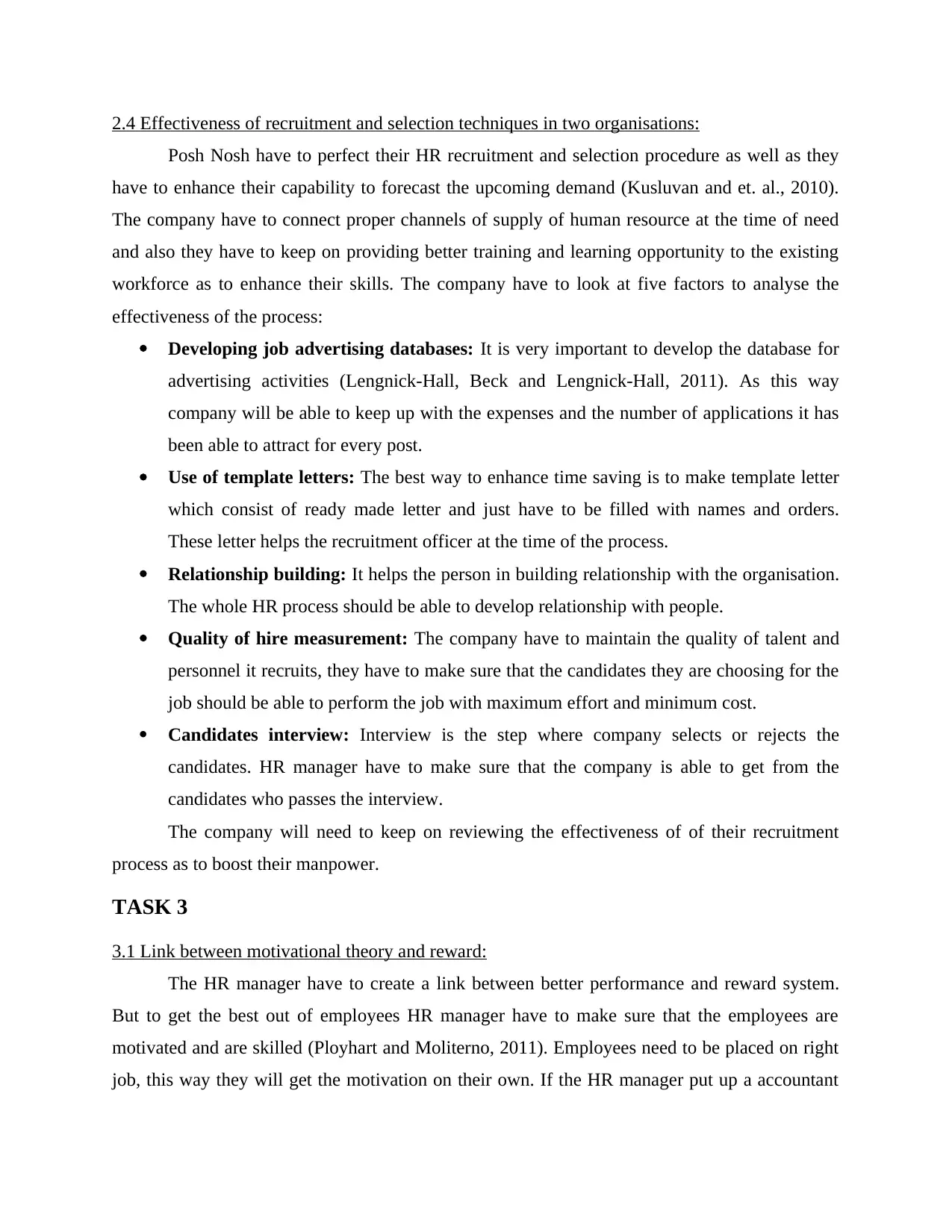
2.4 Effectiveness of recruitment and selection techniques in two organisations:
Posh Nosh have to perfect their HR recruitment and selection procedure as well as they
have to enhance their capability to forecast the upcoming demand (Kusluvan and et. al., 2010).
The company have to connect proper channels of supply of human resource at the time of need
and also they have to keep on providing better training and learning opportunity to the existing
workforce as to enhance their skills. The company have to look at five factors to analyse the
effectiveness of the process:
Developing job advertising databases: It is very important to develop the database for
advertising activities (Lengnick-Hall, Beck and Lengnick-Hall, 2011). As this way
company will be able to keep up with the expenses and the number of applications it has
been able to attract for every post.
Use of template letters: The best way to enhance time saving is to make template letter
which consist of ready made letter and just have to be filled with names and orders.
These letter helps the recruitment officer at the time of the process.
Relationship building: It helps the person in building relationship with the organisation.
The whole HR process should be able to develop relationship with people.
Quality of hire measurement: The company have to maintain the quality of talent and
personnel it recruits, they have to make sure that the candidates they are choosing for the
job should be able to perform the job with maximum effort and minimum cost.
Candidates interview: Interview is the step where company selects or rejects the
candidates. HR manager have to make sure that the company is able to get from the
candidates who passes the interview.
The company will need to keep on reviewing the effectiveness of of their recruitment
process as to boost their manpower.
TASK 3
3.1 Link between motivational theory and reward:
The HR manager have to create a link between better performance and reward system.
But to get the best out of employees HR manager have to make sure that the employees are
motivated and are skilled (Ployhart and Moliterno, 2011). Employees need to be placed on right
job, this way they will get the motivation on their own. If the HR manager put up a accountant
Posh Nosh have to perfect their HR recruitment and selection procedure as well as they
have to enhance their capability to forecast the upcoming demand (Kusluvan and et. al., 2010).
The company have to connect proper channels of supply of human resource at the time of need
and also they have to keep on providing better training and learning opportunity to the existing
workforce as to enhance their skills. The company have to look at five factors to analyse the
effectiveness of the process:
Developing job advertising databases: It is very important to develop the database for
advertising activities (Lengnick-Hall, Beck and Lengnick-Hall, 2011). As this way
company will be able to keep up with the expenses and the number of applications it has
been able to attract for every post.
Use of template letters: The best way to enhance time saving is to make template letter
which consist of ready made letter and just have to be filled with names and orders.
These letter helps the recruitment officer at the time of the process.
Relationship building: It helps the person in building relationship with the organisation.
The whole HR process should be able to develop relationship with people.
Quality of hire measurement: The company have to maintain the quality of talent and
personnel it recruits, they have to make sure that the candidates they are choosing for the
job should be able to perform the job with maximum effort and minimum cost.
Candidates interview: Interview is the step where company selects or rejects the
candidates. HR manager have to make sure that the company is able to get from the
candidates who passes the interview.
The company will need to keep on reviewing the effectiveness of of their recruitment
process as to boost their manpower.
TASK 3
3.1 Link between motivational theory and reward:
The HR manager have to create a link between better performance and reward system.
But to get the best out of employees HR manager have to make sure that the employees are
motivated and are skilled (Ployhart and Moliterno, 2011). Employees need to be placed on right
job, this way they will get the motivation on their own. If the HR manager put up a accountant
Secure Best Marks with AI Grader
Need help grading? Try our AI Grader for instant feedback on your assignments.
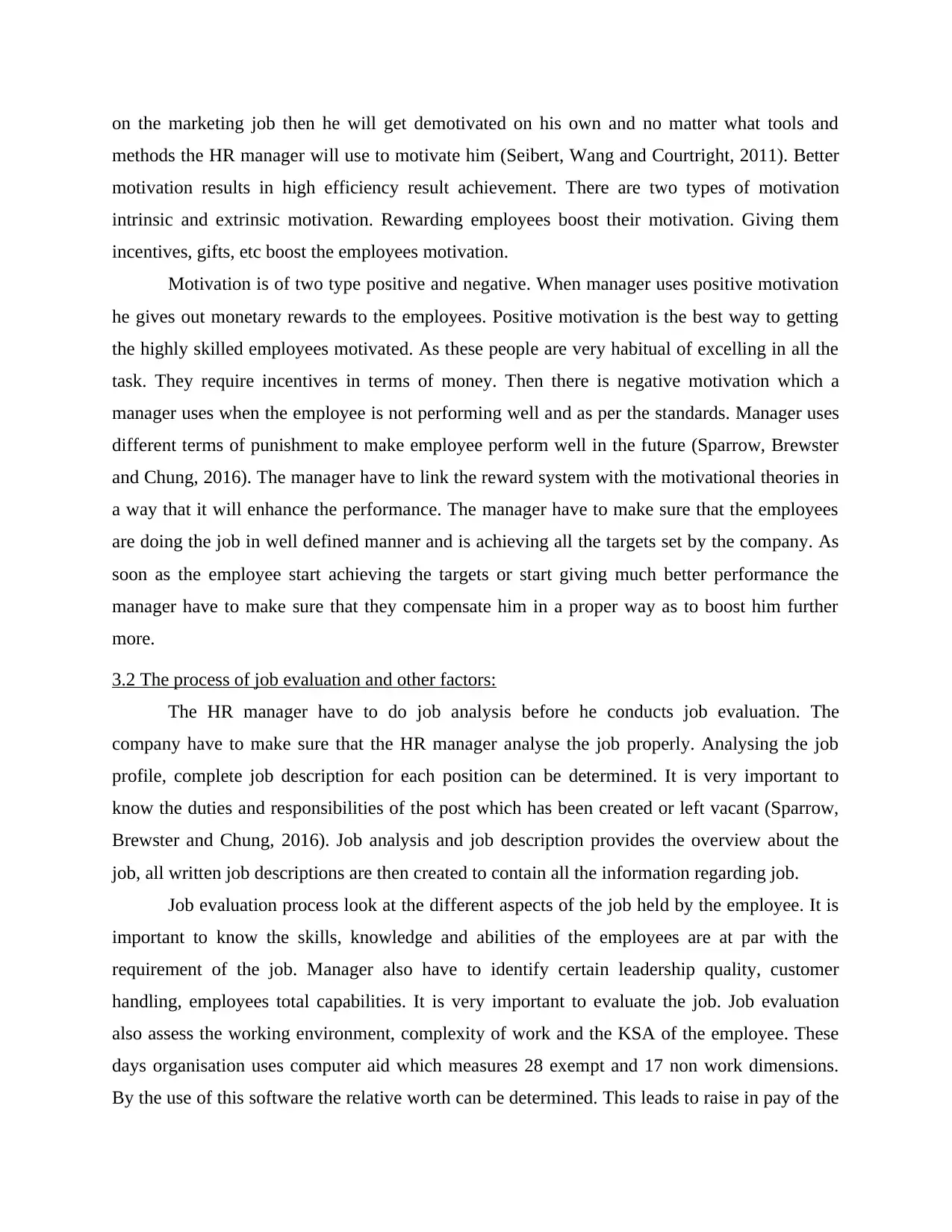
on the marketing job then he will get demotivated on his own and no matter what tools and
methods the HR manager will use to motivate him (Seibert, Wang and Courtright, 2011). Better
motivation results in high efficiency result achievement. There are two types of motivation
intrinsic and extrinsic motivation. Rewarding employees boost their motivation. Giving them
incentives, gifts, etc boost the employees motivation.
Motivation is of two type positive and negative. When manager uses positive motivation
he gives out monetary rewards to the employees. Positive motivation is the best way to getting
the highly skilled employees motivated. As these people are very habitual of excelling in all the
task. They require incentives in terms of money. Then there is negative motivation which a
manager uses when the employee is not performing well and as per the standards. Manager uses
different terms of punishment to make employee perform well in the future (Sparrow, Brewster
and Chung, 2016). The manager have to link the reward system with the motivational theories in
a way that it will enhance the performance. The manager have to make sure that the employees
are doing the job in well defined manner and is achieving all the targets set by the company. As
soon as the employee start achieving the targets or start giving much better performance the
manager have to make sure that they compensate him in a proper way as to boost him further
more.
3.2 The process of job evaluation and other factors:
The HR manager have to do job analysis before he conducts job evaluation. The
company have to make sure that the HR manager analyse the job properly. Analysing the job
profile, complete job description for each position can be determined. It is very important to
know the duties and responsibilities of the post which has been created or left vacant (Sparrow,
Brewster and Chung, 2016). Job analysis and job description provides the overview about the
job, all written job descriptions are then created to contain all the information regarding job.
Job evaluation process look at the different aspects of the job held by the employee. It is
important to know the skills, knowledge and abilities of the employees are at par with the
requirement of the job. Manager also have to identify certain leadership quality, customer
handling, employees total capabilities. It is very important to evaluate the job. Job evaluation
also assess the working environment, complexity of work and the KSA of the employee. These
days organisation uses computer aid which measures 28 exempt and 17 non work dimensions.
By the use of this software the relative worth can be determined. This leads to raise in pay of the
methods the HR manager will use to motivate him (Seibert, Wang and Courtright, 2011). Better
motivation results in high efficiency result achievement. There are two types of motivation
intrinsic and extrinsic motivation. Rewarding employees boost their motivation. Giving them
incentives, gifts, etc boost the employees motivation.
Motivation is of two type positive and negative. When manager uses positive motivation
he gives out monetary rewards to the employees. Positive motivation is the best way to getting
the highly skilled employees motivated. As these people are very habitual of excelling in all the
task. They require incentives in terms of money. Then there is negative motivation which a
manager uses when the employee is not performing well and as per the standards. Manager uses
different terms of punishment to make employee perform well in the future (Sparrow, Brewster
and Chung, 2016). The manager have to link the reward system with the motivational theories in
a way that it will enhance the performance. The manager have to make sure that the employees
are doing the job in well defined manner and is achieving all the targets set by the company. As
soon as the employee start achieving the targets or start giving much better performance the
manager have to make sure that they compensate him in a proper way as to boost him further
more.
3.2 The process of job evaluation and other factors:
The HR manager have to do job analysis before he conducts job evaluation. The
company have to make sure that the HR manager analyse the job properly. Analysing the job
profile, complete job description for each position can be determined. It is very important to
know the duties and responsibilities of the post which has been created or left vacant (Sparrow,
Brewster and Chung, 2016). Job analysis and job description provides the overview about the
job, all written job descriptions are then created to contain all the information regarding job.
Job evaluation process look at the different aspects of the job held by the employee. It is
important to know the skills, knowledge and abilities of the employees are at par with the
requirement of the job. Manager also have to identify certain leadership quality, customer
handling, employees total capabilities. It is very important to evaluate the job. Job evaluation
also assess the working environment, complexity of work and the KSA of the employee. These
days organisation uses computer aid which measures 28 exempt and 17 non work dimensions.
By the use of this software the relative worth can be determined. This leads to raise in pay of the
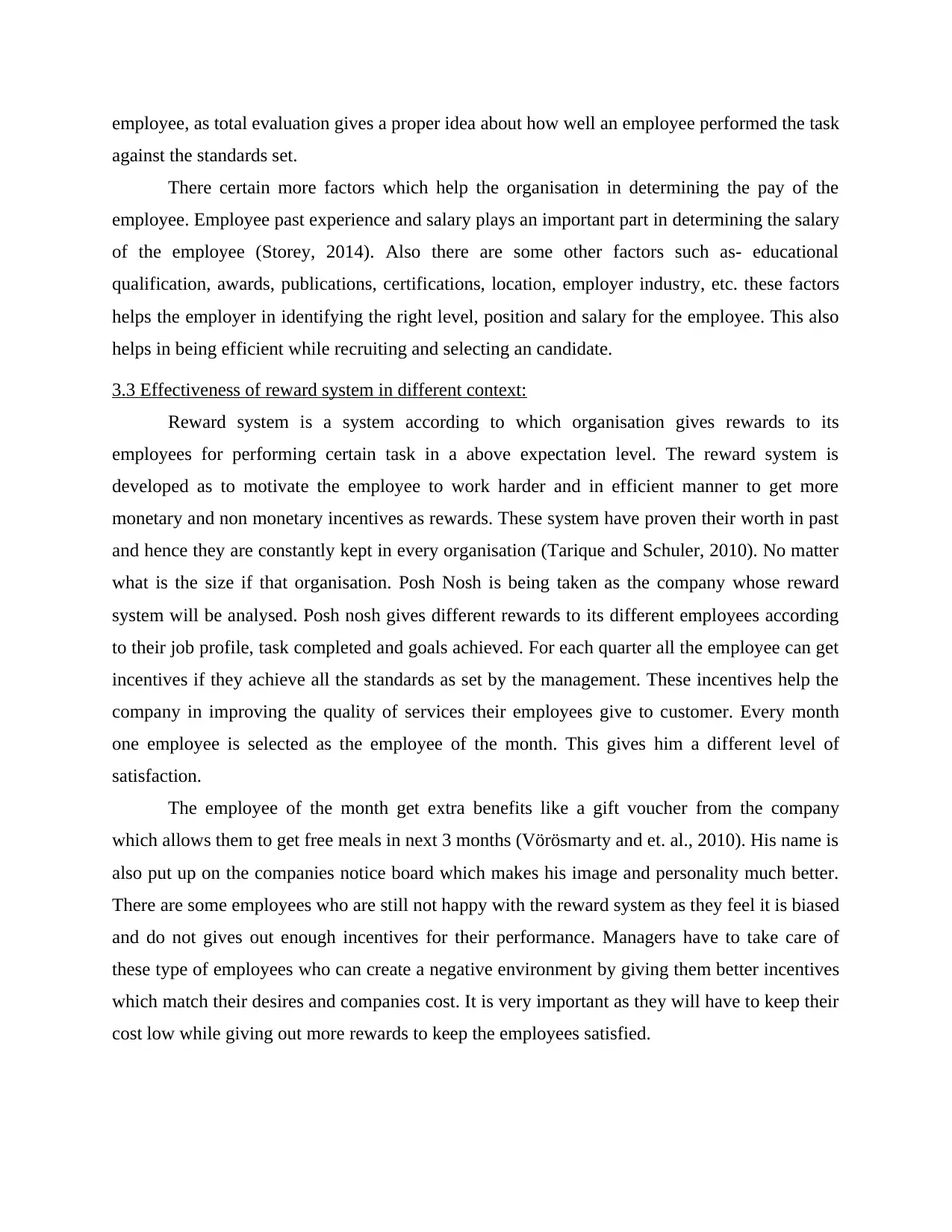
employee, as total evaluation gives a proper idea about how well an employee performed the task
against the standards set.
There certain more factors which help the organisation in determining the pay of the
employee. Employee past experience and salary plays an important part in determining the salary
of the employee (Storey, 2014). Also there are some other factors such as- educational
qualification, awards, publications, certifications, location, employer industry, etc. these factors
helps the employer in identifying the right level, position and salary for the employee. This also
helps in being efficient while recruiting and selecting an candidate.
3.3 Effectiveness of reward system in different context:
Reward system is a system according to which organisation gives rewards to its
employees for performing certain task in a above expectation level. The reward system is
developed as to motivate the employee to work harder and in efficient manner to get more
monetary and non monetary incentives as rewards. These system have proven their worth in past
and hence they are constantly kept in every organisation (Tarique and Schuler, 2010). No matter
what is the size if that organisation. Posh Nosh is being taken as the company whose reward
system will be analysed. Posh nosh gives different rewards to its different employees according
to their job profile, task completed and goals achieved. For each quarter all the employee can get
incentives if they achieve all the standards as set by the management. These incentives help the
company in improving the quality of services their employees give to customer. Every month
one employee is selected as the employee of the month. This gives him a different level of
satisfaction.
The employee of the month get extra benefits like a gift voucher from the company
which allows them to get free meals in next 3 months (Vörösmarty and et. al., 2010). His name is
also put up on the companies notice board which makes his image and personality much better.
There are some employees who are still not happy with the reward system as they feel it is biased
and do not gives out enough incentives for their performance. Managers have to take care of
these type of employees who can create a negative environment by giving them better incentives
which match their desires and companies cost. It is very important as they will have to keep their
cost low while giving out more rewards to keep the employees satisfied.
against the standards set.
There certain more factors which help the organisation in determining the pay of the
employee. Employee past experience and salary plays an important part in determining the salary
of the employee (Storey, 2014). Also there are some other factors such as- educational
qualification, awards, publications, certifications, location, employer industry, etc. these factors
helps the employer in identifying the right level, position and salary for the employee. This also
helps in being efficient while recruiting and selecting an candidate.
3.3 Effectiveness of reward system in different context:
Reward system is a system according to which organisation gives rewards to its
employees for performing certain task in a above expectation level. The reward system is
developed as to motivate the employee to work harder and in efficient manner to get more
monetary and non monetary incentives as rewards. These system have proven their worth in past
and hence they are constantly kept in every organisation (Tarique and Schuler, 2010). No matter
what is the size if that organisation. Posh Nosh is being taken as the company whose reward
system will be analysed. Posh nosh gives different rewards to its different employees according
to their job profile, task completed and goals achieved. For each quarter all the employee can get
incentives if they achieve all the standards as set by the management. These incentives help the
company in improving the quality of services their employees give to customer. Every month
one employee is selected as the employee of the month. This gives him a different level of
satisfaction.
The employee of the month get extra benefits like a gift voucher from the company
which allows them to get free meals in next 3 months (Vörösmarty and et. al., 2010). His name is
also put up on the companies notice board which makes his image and personality much better.
There are some employees who are still not happy with the reward system as they feel it is biased
and do not gives out enough incentives for their performance. Managers have to take care of
these type of employees who can create a negative environment by giving them better incentives
which match their desires and companies cost. It is very important as they will have to keep their
cost low while giving out more rewards to keep the employees satisfied.
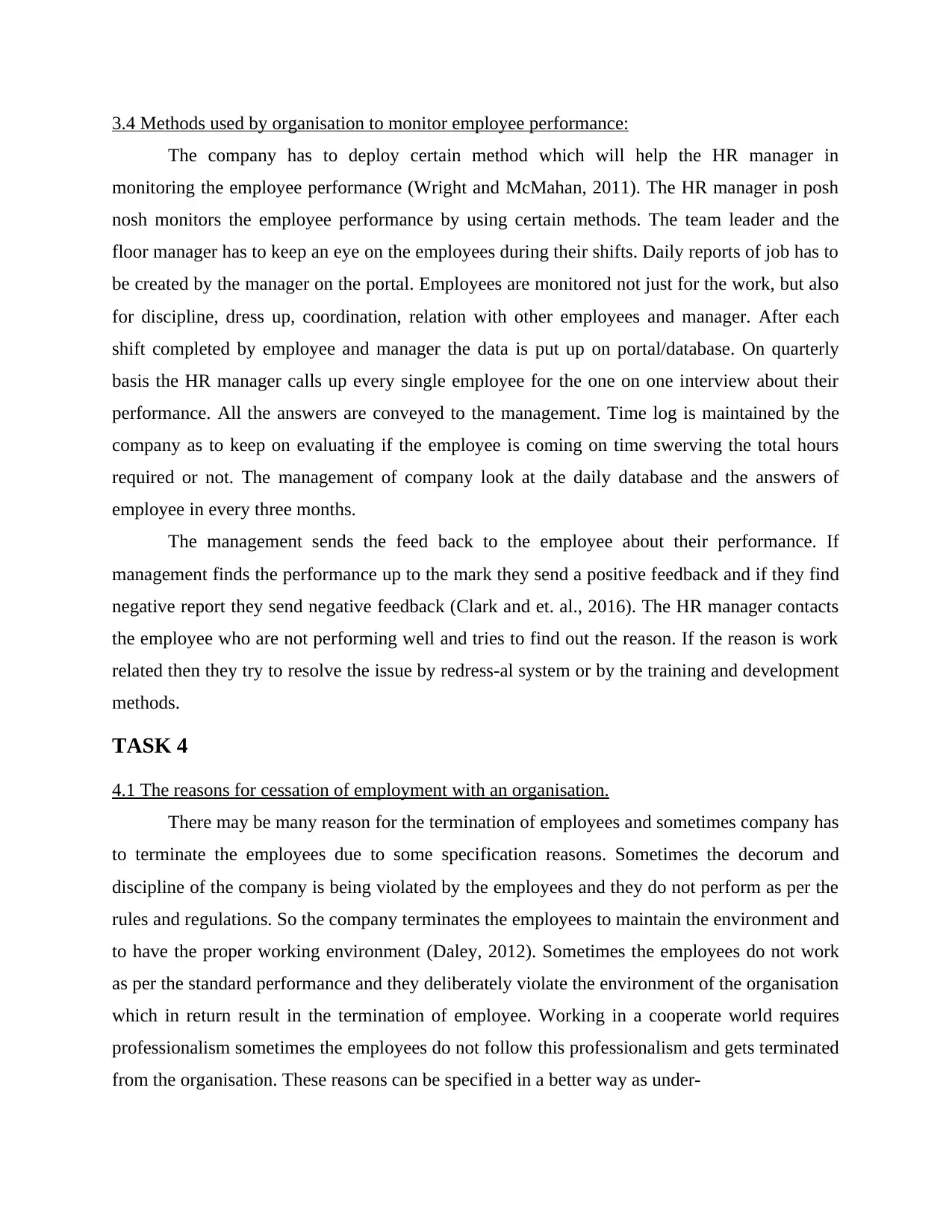
3.4 Methods used by organisation to monitor employee performance:
The company has to deploy certain method which will help the HR manager in
monitoring the employee performance (Wright and McMahan, 2011). The HR manager in posh
nosh monitors the employee performance by using certain methods. The team leader and the
floor manager has to keep an eye on the employees during their shifts. Daily reports of job has to
be created by the manager on the portal. Employees are monitored not just for the work, but also
for discipline, dress up, coordination, relation with other employees and manager. After each
shift completed by employee and manager the data is put up on portal/database. On quarterly
basis the HR manager calls up every single employee for the one on one interview about their
performance. All the answers are conveyed to the management. Time log is maintained by the
company as to keep on evaluating if the employee is coming on time swerving the total hours
required or not. The management of company look at the daily database and the answers of
employee in every three months.
The management sends the feed back to the employee about their performance. If
management finds the performance up to the mark they send a positive feedback and if they find
negative report they send negative feedback (Clark and et. al., 2016). The HR manager contacts
the employee who are not performing well and tries to find out the reason. If the reason is work
related then they try to resolve the issue by redress-al system or by the training and development
methods.
TASK 4
4.1 The reasons for cessation of employment with an organisation.
There may be many reason for the termination of employees and sometimes company has
to terminate the employees due to some specification reasons. Sometimes the decorum and
discipline of the company is being violated by the employees and they do not perform as per the
rules and regulations. So the company terminates the employees to maintain the environment and
to have the proper working environment (Daley, 2012). Sometimes the employees do not work
as per the standard performance and they deliberately violate the environment of the organisation
which in return result in the termination of employee. Working in a cooperate world requires
professionalism sometimes the employees do not follow this professionalism and gets terminated
from the organisation. These reasons can be specified in a better way as under-
The company has to deploy certain method which will help the HR manager in
monitoring the employee performance (Wright and McMahan, 2011). The HR manager in posh
nosh monitors the employee performance by using certain methods. The team leader and the
floor manager has to keep an eye on the employees during their shifts. Daily reports of job has to
be created by the manager on the portal. Employees are monitored not just for the work, but also
for discipline, dress up, coordination, relation with other employees and manager. After each
shift completed by employee and manager the data is put up on portal/database. On quarterly
basis the HR manager calls up every single employee for the one on one interview about their
performance. All the answers are conveyed to the management. Time log is maintained by the
company as to keep on evaluating if the employee is coming on time swerving the total hours
required or not. The management of company look at the daily database and the answers of
employee in every three months.
The management sends the feed back to the employee about their performance. If
management finds the performance up to the mark they send a positive feedback and if they find
negative report they send negative feedback (Clark and et. al., 2016). The HR manager contacts
the employee who are not performing well and tries to find out the reason. If the reason is work
related then they try to resolve the issue by redress-al system or by the training and development
methods.
TASK 4
4.1 The reasons for cessation of employment with an organisation.
There may be many reason for the termination of employees and sometimes company has
to terminate the employees due to some specification reasons. Sometimes the decorum and
discipline of the company is being violated by the employees and they do not perform as per the
rules and regulations. So the company terminates the employees to maintain the environment and
to have the proper working environment (Daley, 2012). Sometimes the employees do not work
as per the standard performance and they deliberately violate the environment of the organisation
which in return result in the termination of employee. Working in a cooperate world requires
professionalism sometimes the employees do not follow this professionalism and gets terminated
from the organisation. These reasons can be specified in a better way as under-
Paraphrase This Document
Need a fresh take? Get an instant paraphrase of this document with our AI Paraphraser
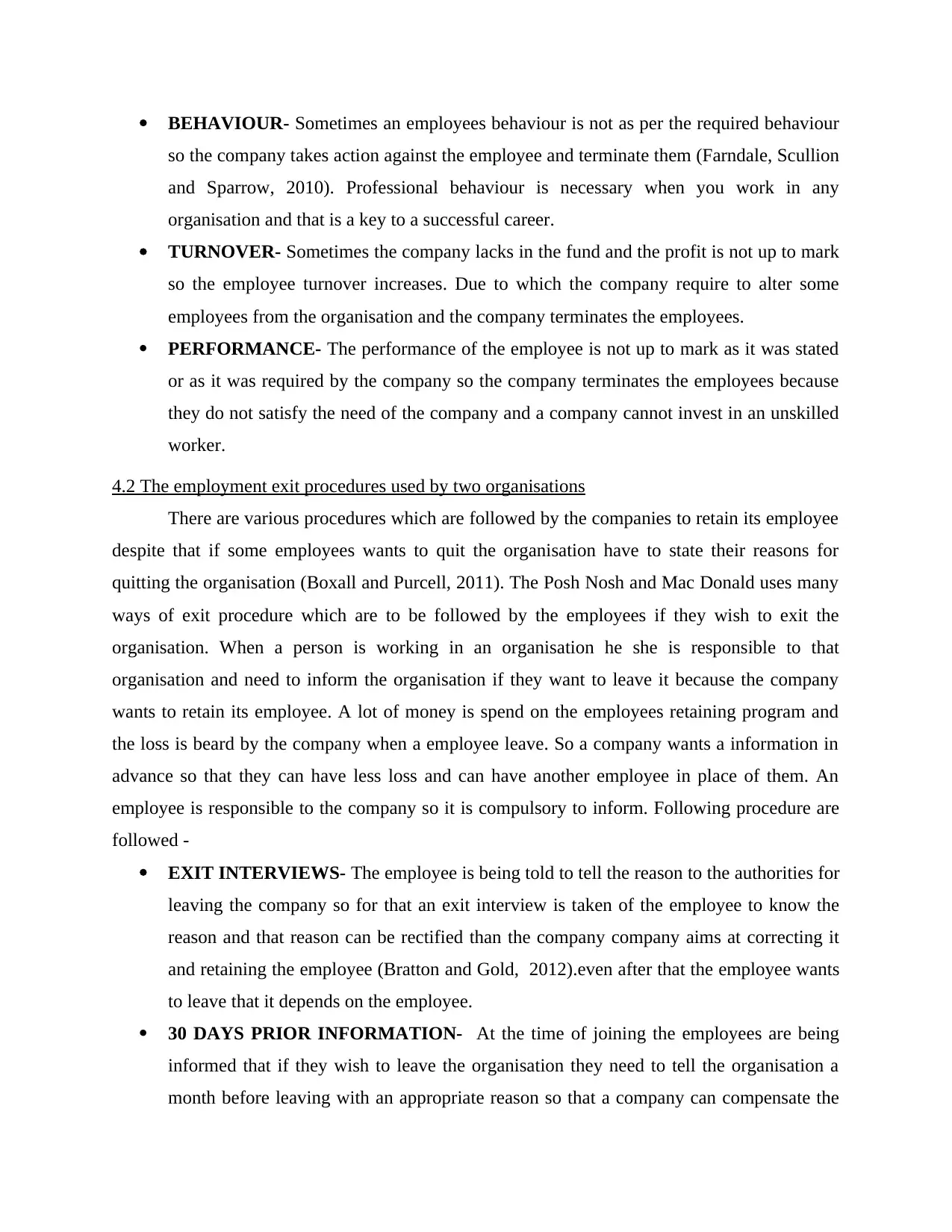
BEHAVIOUR- Sometimes an employees behaviour is not as per the required behaviour
so the company takes action against the employee and terminate them (Farndale, Scullion
and Sparrow, 2010). Professional behaviour is necessary when you work in any
organisation and that is a key to a successful career.
TURNOVER- Sometimes the company lacks in the fund and the profit is not up to mark
so the employee turnover increases. Due to which the company require to alter some
employees from the organisation and the company terminates the employees.
PERFORMANCE- The performance of the employee is not up to mark as it was stated
or as it was required by the company so the company terminates the employees because
they do not satisfy the need of the company and a company cannot invest in an unskilled
worker.
4.2 The employment exit procedures used by two organisations
There are various procedures which are followed by the companies to retain its employee
despite that if some employees wants to quit the organisation have to state their reasons for
quitting the organisation (Boxall and Purcell, 2011). The Posh Nosh and Mac Donald uses many
ways of exit procedure which are to be followed by the employees if they wish to exit the
organisation. When a person is working in an organisation he she is responsible to that
organisation and need to inform the organisation if they want to leave it because the company
wants to retain its employee. A lot of money is spend on the employees retaining program and
the loss is beard by the company when a employee leave. So a company wants a information in
advance so that they can have less loss and can have another employee in place of them. An
employee is responsible to the company so it is compulsory to inform. Following procedure are
followed -
EXIT INTERVIEWS- The employee is being told to tell the reason to the authorities for
leaving the company so for that an exit interview is taken of the employee to know the
reason and that reason can be rectified than the company company aims at correcting it
and retaining the employee (Bratton and Gold, 2012).even after that the employee wants
to leave that it depends on the employee.
30 DAYS PRIOR INFORMATION- At the time of joining the employees are being
informed that if they wish to leave the organisation they need to tell the organisation a
month before leaving with an appropriate reason so that a company can compensate the
so the company takes action against the employee and terminate them (Farndale, Scullion
and Sparrow, 2010). Professional behaviour is necessary when you work in any
organisation and that is a key to a successful career.
TURNOVER- Sometimes the company lacks in the fund and the profit is not up to mark
so the employee turnover increases. Due to which the company require to alter some
employees from the organisation and the company terminates the employees.
PERFORMANCE- The performance of the employee is not up to mark as it was stated
or as it was required by the company so the company terminates the employees because
they do not satisfy the need of the company and a company cannot invest in an unskilled
worker.
4.2 The employment exit procedures used by two organisations
There are various procedures which are followed by the companies to retain its employee
despite that if some employees wants to quit the organisation have to state their reasons for
quitting the organisation (Boxall and Purcell, 2011). The Posh Nosh and Mac Donald uses many
ways of exit procedure which are to be followed by the employees if they wish to exit the
organisation. When a person is working in an organisation he she is responsible to that
organisation and need to inform the organisation if they want to leave it because the company
wants to retain its employee. A lot of money is spend on the employees retaining program and
the loss is beard by the company when a employee leave. So a company wants a information in
advance so that they can have less loss and can have another employee in place of them. An
employee is responsible to the company so it is compulsory to inform. Following procedure are
followed -
EXIT INTERVIEWS- The employee is being told to tell the reason to the authorities for
leaving the company so for that an exit interview is taken of the employee to know the
reason and that reason can be rectified than the company company aims at correcting it
and retaining the employee (Bratton and Gold, 2012).even after that the employee wants
to leave that it depends on the employee.
30 DAYS PRIOR INFORMATION- At the time of joining the employees are being
informed that if they wish to leave the organisation they need to tell the organisation a
month before leaving with an appropriate reason so that a company can compensate the
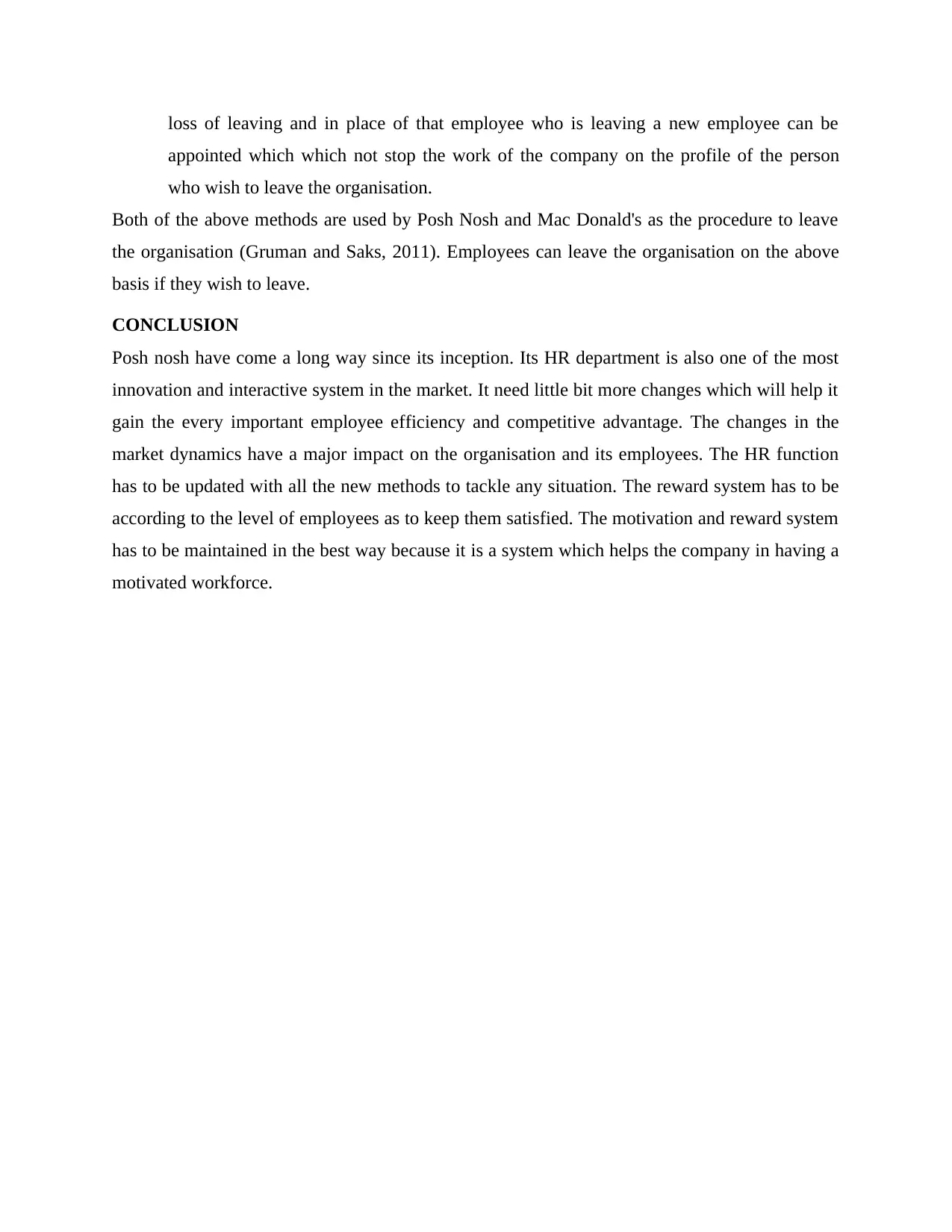
loss of leaving and in place of that employee who is leaving a new employee can be
appointed which which not stop the work of the company on the profile of the person
who wish to leave the organisation.
Both of the above methods are used by Posh Nosh and Mac Donald's as the procedure to leave
the organisation (Gruman and Saks, 2011). Employees can leave the organisation on the above
basis if they wish to leave.
CONCLUSION
Posh nosh have come a long way since its inception. Its HR department is also one of the most
innovation and interactive system in the market. It need little bit more changes which will help it
gain the every important employee efficiency and competitive advantage. The changes in the
market dynamics have a major impact on the organisation and its employees. The HR function
has to be updated with all the new methods to tackle any situation. The reward system has to be
according to the level of employees as to keep them satisfied. The motivation and reward system
has to be maintained in the best way because it is a system which helps the company in having a
motivated workforce.
appointed which which not stop the work of the company on the profile of the person
who wish to leave the organisation.
Both of the above methods are used by Posh Nosh and Mac Donald's as the procedure to leave
the organisation (Gruman and Saks, 2011). Employees can leave the organisation on the above
basis if they wish to leave.
CONCLUSION
Posh nosh have come a long way since its inception. Its HR department is also one of the most
innovation and interactive system in the market. It need little bit more changes which will help it
gain the every important employee efficiency and competitive advantage. The changes in the
market dynamics have a major impact on the organisation and its employees. The HR function
has to be updated with all the new methods to tackle any situation. The reward system has to be
according to the level of employees as to keep them satisfied. The motivation and reward system
has to be maintained in the best way because it is a system which helps the company in having a
motivated workforce.
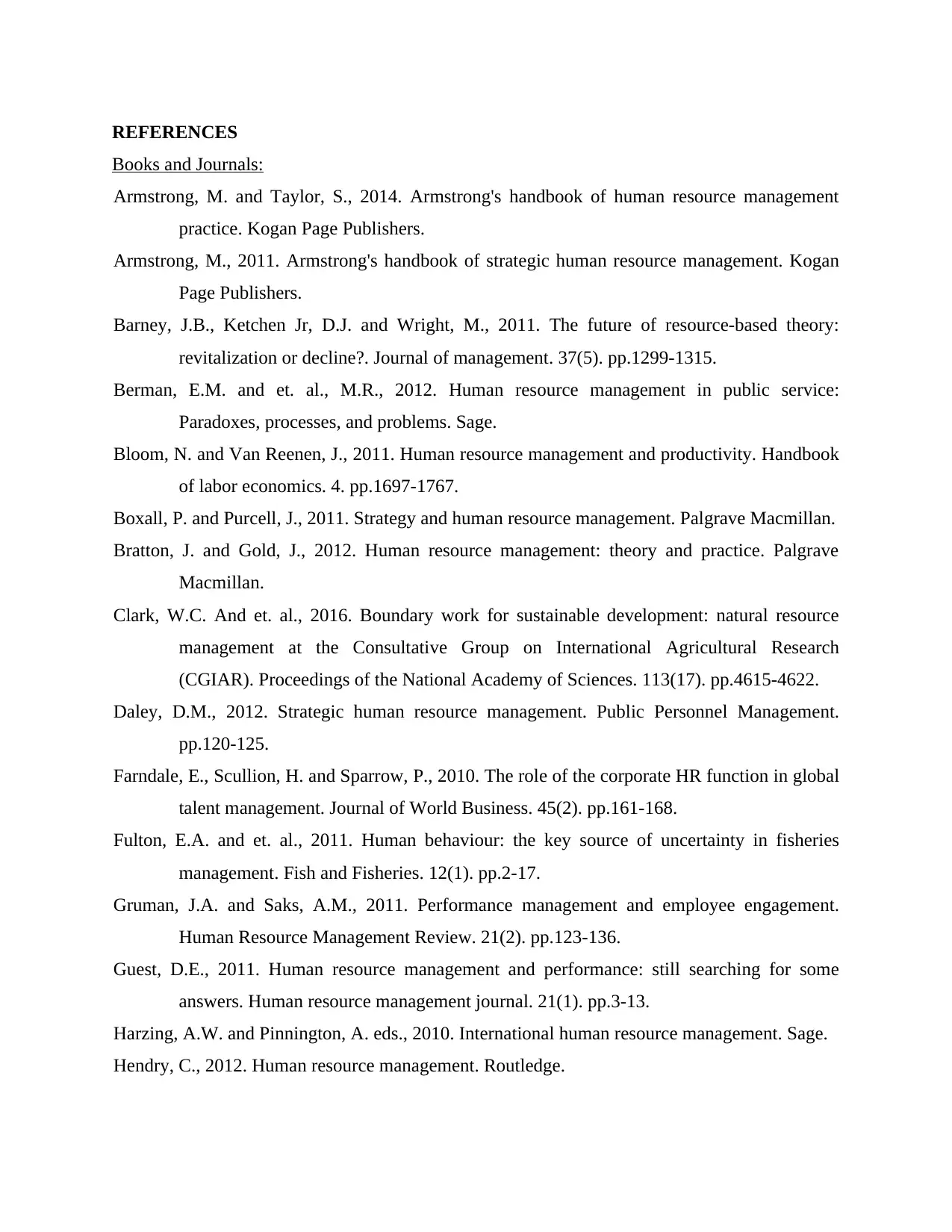
REFERENCES
Books and Journals:
Armstrong, M. and Taylor, S., 2014. Armstrong's handbook of human resource management
practice. Kogan Page Publishers.
Armstrong, M., 2011. Armstrong's handbook of strategic human resource management. Kogan
Page Publishers.
Barney, J.B., Ketchen Jr, D.J. and Wright, M., 2011. The future of resource-based theory:
revitalization or decline?. Journal of management. 37(5). pp.1299-1315.
Berman, E.M. and et. al., M.R., 2012. Human resource management in public service:
Paradoxes, processes, and problems. Sage.
Bloom, N. and Van Reenen, J., 2011. Human resource management and productivity. Handbook
of labor economics. 4. pp.1697-1767.
Boxall, P. and Purcell, J., 2011. Strategy and human resource management. Palgrave Macmillan.
Bratton, J. and Gold, J., 2012. Human resource management: theory and practice. Palgrave
Macmillan.
Clark, W.C. And et. al., 2016. Boundary work for sustainable development: natural resource
management at the Consultative Group on International Agricultural Research
(CGIAR). Proceedings of the National Academy of Sciences. 113(17). pp.4615-4622.
Daley, D.M., 2012. Strategic human resource management. Public Personnel Management.
pp.120-125.
Farndale, E., Scullion, H. and Sparrow, P., 2010. The role of the corporate HR function in global
talent management. Journal of World Business. 45(2). pp.161-168.
Fulton, E.A. and et. al., 2011. Human behaviour: the key source of uncertainty in fisheries
management. Fish and Fisheries. 12(1). pp.2-17.
Gruman, J.A. and Saks, A.M., 2011. Performance management and employee engagement.
Human Resource Management Review. 21(2). pp.123-136.
Guest, D.E., 2011. Human resource management and performance: still searching for some
answers. Human resource management journal. 21(1). pp.3-13.
Harzing, A.W. and Pinnington, A. eds., 2010. International human resource management. Sage.
Hendry, C., 2012. Human resource management. Routledge.
Books and Journals:
Armstrong, M. and Taylor, S., 2014. Armstrong's handbook of human resource management
practice. Kogan Page Publishers.
Armstrong, M., 2011. Armstrong's handbook of strategic human resource management. Kogan
Page Publishers.
Barney, J.B., Ketchen Jr, D.J. and Wright, M., 2011. The future of resource-based theory:
revitalization or decline?. Journal of management. 37(5). pp.1299-1315.
Berman, E.M. and et. al., M.R., 2012. Human resource management in public service:
Paradoxes, processes, and problems. Sage.
Bloom, N. and Van Reenen, J., 2011. Human resource management and productivity. Handbook
of labor economics. 4. pp.1697-1767.
Boxall, P. and Purcell, J., 2011. Strategy and human resource management. Palgrave Macmillan.
Bratton, J. and Gold, J., 2012. Human resource management: theory and practice. Palgrave
Macmillan.
Clark, W.C. And et. al., 2016. Boundary work for sustainable development: natural resource
management at the Consultative Group on International Agricultural Research
(CGIAR). Proceedings of the National Academy of Sciences. 113(17). pp.4615-4622.
Daley, D.M., 2012. Strategic human resource management. Public Personnel Management.
pp.120-125.
Farndale, E., Scullion, H. and Sparrow, P., 2010. The role of the corporate HR function in global
talent management. Journal of World Business. 45(2). pp.161-168.
Fulton, E.A. and et. al., 2011. Human behaviour: the key source of uncertainty in fisheries
management. Fish and Fisheries. 12(1). pp.2-17.
Gruman, J.A. and Saks, A.M., 2011. Performance management and employee engagement.
Human Resource Management Review. 21(2). pp.123-136.
Guest, D.E., 2011. Human resource management and performance: still searching for some
answers. Human resource management journal. 21(1). pp.3-13.
Harzing, A.W. and Pinnington, A. eds., 2010. International human resource management. Sage.
Hendry, C., 2012. Human resource management. Routledge.
Secure Best Marks with AI Grader
Need help grading? Try our AI Grader for instant feedback on your assignments.
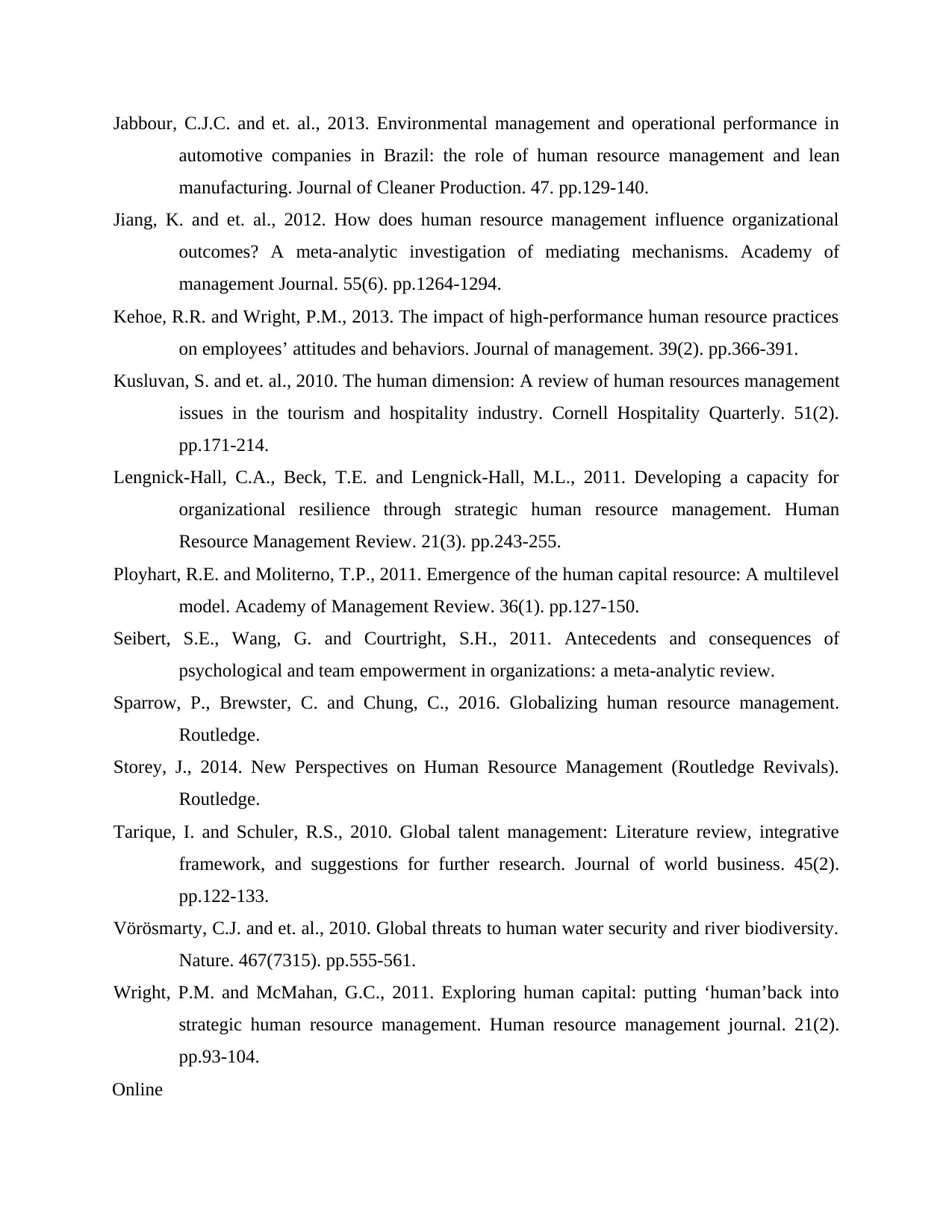
Jabbour, C.J.C. and et. al., 2013. Environmental management and operational performance in
automotive companies in Brazil: the role of human resource management and lean
manufacturing. Journal of Cleaner Production. 47. pp.129-140.
Jiang, K. and et. al., 2012. How does human resource management influence organizational
outcomes? A meta-analytic investigation of mediating mechanisms. Academy of
management Journal. 55(6). pp.1264-1294.
Kehoe, R.R. and Wright, P.M., 2013. The impact of high-performance human resource practices
on employees’ attitudes and behaviors. Journal of management. 39(2). pp.366-391.
Kusluvan, S. and et. al., 2010. The human dimension: A review of human resources management
issues in the tourism and hospitality industry. Cornell Hospitality Quarterly. 51(2).
pp.171-214.
Lengnick-Hall, C.A., Beck, T.E. and Lengnick-Hall, M.L., 2011. Developing a capacity for
organizational resilience through strategic human resource management. Human
Resource Management Review. 21(3). pp.243-255.
Ployhart, R.E. and Moliterno, T.P., 2011. Emergence of the human capital resource: A multilevel
model. Academy of Management Review. 36(1). pp.127-150.
Seibert, S.E., Wang, G. and Courtright, S.H., 2011. Antecedents and consequences of
psychological and team empowerment in organizations: a meta-analytic review.
Sparrow, P., Brewster, C. and Chung, C., 2016. Globalizing human resource management.
Routledge.
Storey, J., 2014. New Perspectives on Human Resource Management (Routledge Revivals).
Routledge.
Tarique, I. and Schuler, R.S., 2010. Global talent management: Literature review, integrative
framework, and suggestions for further research. Journal of world business. 45(2).
pp.122-133.
Vörösmarty, C.J. and et. al., 2010. Global threats to human water security and river biodiversity.
Nature. 467(7315). pp.555-561.
Wright, P.M. and McMahan, G.C., 2011. Exploring human capital: putting ‘human’back into
strategic human resource management. Human resource management journal. 21(2).
pp.93-104.
Online
automotive companies in Brazil: the role of human resource management and lean
manufacturing. Journal of Cleaner Production. 47. pp.129-140.
Jiang, K. and et. al., 2012. How does human resource management influence organizational
outcomes? A meta-analytic investigation of mediating mechanisms. Academy of
management Journal. 55(6). pp.1264-1294.
Kehoe, R.R. and Wright, P.M., 2013. The impact of high-performance human resource practices
on employees’ attitudes and behaviors. Journal of management. 39(2). pp.366-391.
Kusluvan, S. and et. al., 2010. The human dimension: A review of human resources management
issues in the tourism and hospitality industry. Cornell Hospitality Quarterly. 51(2).
pp.171-214.
Lengnick-Hall, C.A., Beck, T.E. and Lengnick-Hall, M.L., 2011. Developing a capacity for
organizational resilience through strategic human resource management. Human
Resource Management Review. 21(3). pp.243-255.
Ployhart, R.E. and Moliterno, T.P., 2011. Emergence of the human capital resource: A multilevel
model. Academy of Management Review. 36(1). pp.127-150.
Seibert, S.E., Wang, G. and Courtright, S.H., 2011. Antecedents and consequences of
psychological and team empowerment in organizations: a meta-analytic review.
Sparrow, P., Brewster, C. and Chung, C., 2016. Globalizing human resource management.
Routledge.
Storey, J., 2014. New Perspectives on Human Resource Management (Routledge Revivals).
Routledge.
Tarique, I. and Schuler, R.S., 2010. Global talent management: Literature review, integrative
framework, and suggestions for further research. Journal of world business. 45(2).
pp.122-133.
Vörösmarty, C.J. and et. al., 2010. Global threats to human water security and river biodiversity.
Nature. 467(7315). pp.555-561.
Wright, P.M. and McMahan, G.C., 2011. Exploring human capital: putting ‘human’back into
strategic human resource management. Human resource management journal. 21(2).
pp.93-104.
Online
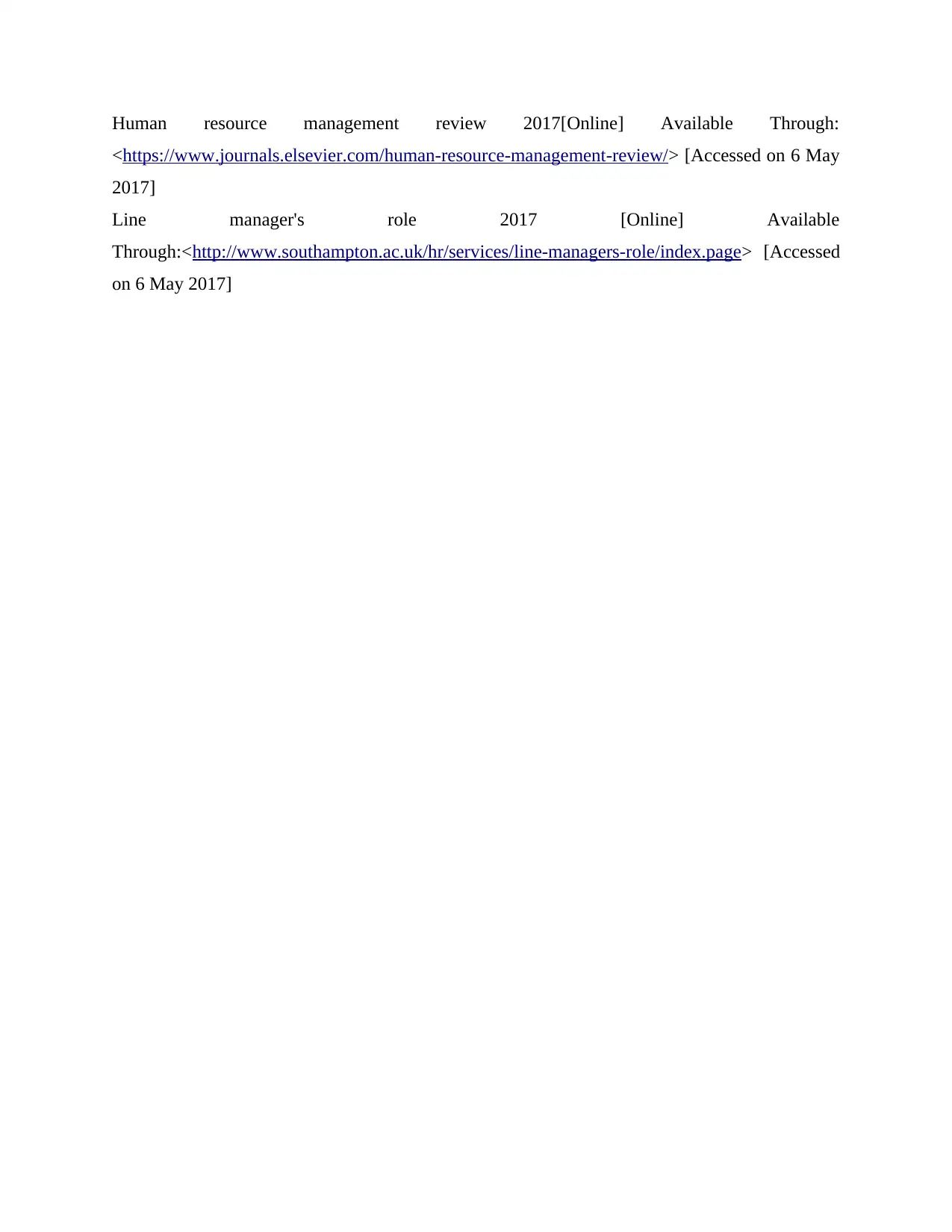
Human resource management review 2017[Online] Available Through:
<https://www.journals.elsevier.com/human-resource-management-review/> [Accessed on 6 May
2017]
Line manager's role 2017 [Online] Available
Through:<http://www.southampton.ac.uk/hr/services/line-managers-role/index.page> [Accessed
on 6 May 2017]
<https://www.journals.elsevier.com/human-resource-management-review/> [Accessed on 6 May
2017]
Line manager's role 2017 [Online] Available
Through:<http://www.southampton.ac.uk/hr/services/line-managers-role/index.page> [Accessed
on 6 May 2017]
1 out of 18
Related Documents
Your All-in-One AI-Powered Toolkit for Academic Success.
+13062052269
info@desklib.com
Available 24*7 on WhatsApp / Email
![[object Object]](/_next/static/media/star-bottom.7253800d.svg)
Unlock your academic potential
© 2024 | Zucol Services PVT LTD | All rights reserved.





